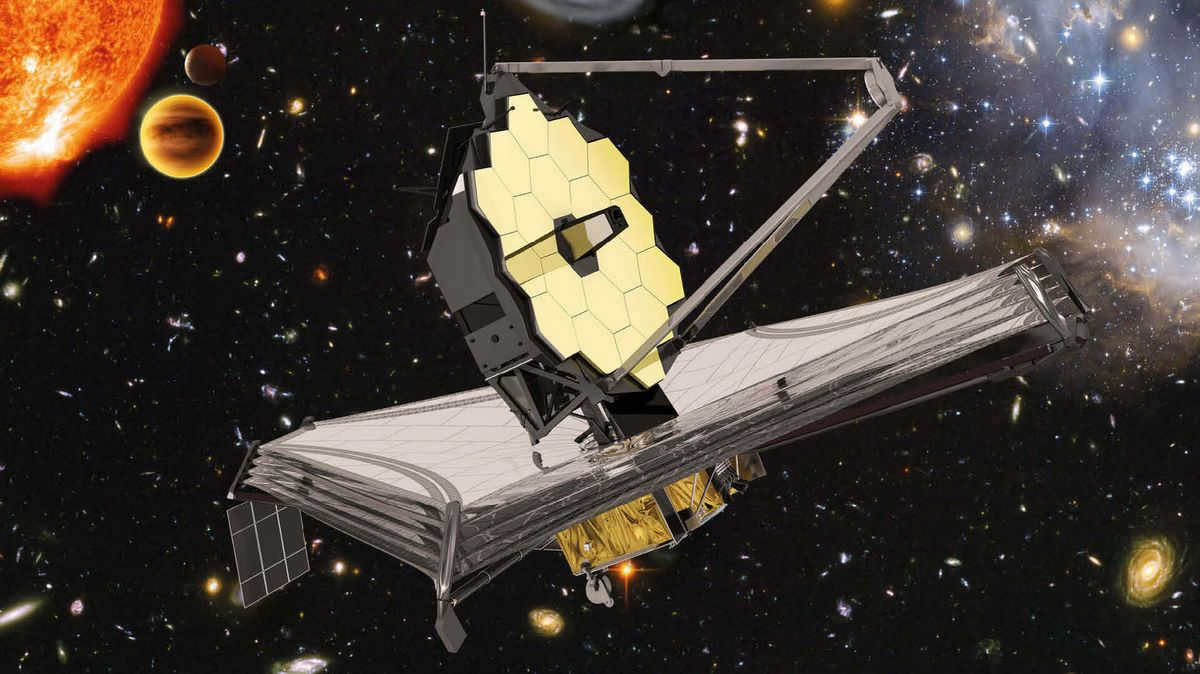Humanity will not remain forever on Earth, but in the pursuit of knowledge and exploration will first cautiously venture beyond the atmosphere, and then conquer the vast expanse of our solar neighborhood.
This website is dedicated to the wonders of our solar system.
A celestial body (also referred to as an astronomical object) is a distinct, cohesive structure held together by gravity. Within our solar system, we have the following celestial bodies:
Astronomers also identify smaller celestial bodies such as dwarf planets, asteroids, comets, meteoroids, and meteors. However, the most significant types of celestial bodies are the planets. They can be further classified as Terrestrial (located closer to the Sun) or Gas Giants (enormous objects found in the outer regions of the system).
Dwarf planets stand apart from their “elder siblings” due to the presence of other celestial objects circling around them and their relatively diminutive size. Currently, there are 5 recognized members in this category: Pluto, Ceres, Erid, Haumea, and Makemake. Between 2017 and 2019, there was speculation that the asteroid Hygeia might also be deemed worthy of inclusion in this esteemed group. Apart from the dwarf planets, our solar system also boasts a variety of other small celestial bodies.
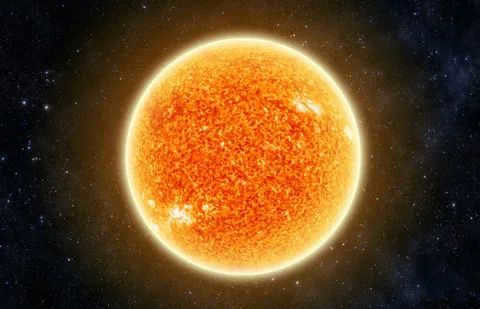
The Sun, an enormous sphere of gas, has a diameter estimated to be 1.392 million kilometers, which is 109 times larger than Earth’s diameter. It comprises 99.87% of the total mass of the solar system.
In astronomical terms, the Sun is categorized as a “yellow dwarf,” indicating that it is relatively small compared to other stars but emits a significant amount of light.
Thermonuclear reactions are responsible for the heat radiated by the star. Within the core of the Sun, hydrogen atoms combine to form helium atoms and release energy. This process, known as the proton-proton cycle, contributes to approximately 98% of the energy generated by the star. Nevertheless, there are additional reactions in which elements like helium, carbon, oxygen, neon, and silicon undergo fusion, resulting in the formation of metals like iron, magnesium, calcium, nickel, as well as other elements like sulfur. Collectively, these processes are referred to as stellar nucleosynthesis.
The impact of the Sun on the surrounding celestial objects is immense. The solar wind, consisting of particles emitted by the star, dominates the space between planets up to a distance of 100-150 astronomical units. It is believed that the gravity of our star influences the orbits of bodies located even light-years away.
The Sun itself undergoes rotation on its axis. Due to its gaseous composition, different layers of the Sun rotate at varying speeds. The equator completes one rotation every 25 days, while the poles take 34 days. Recent research also indicates that the inner regions rotate much faster than the outer shell.
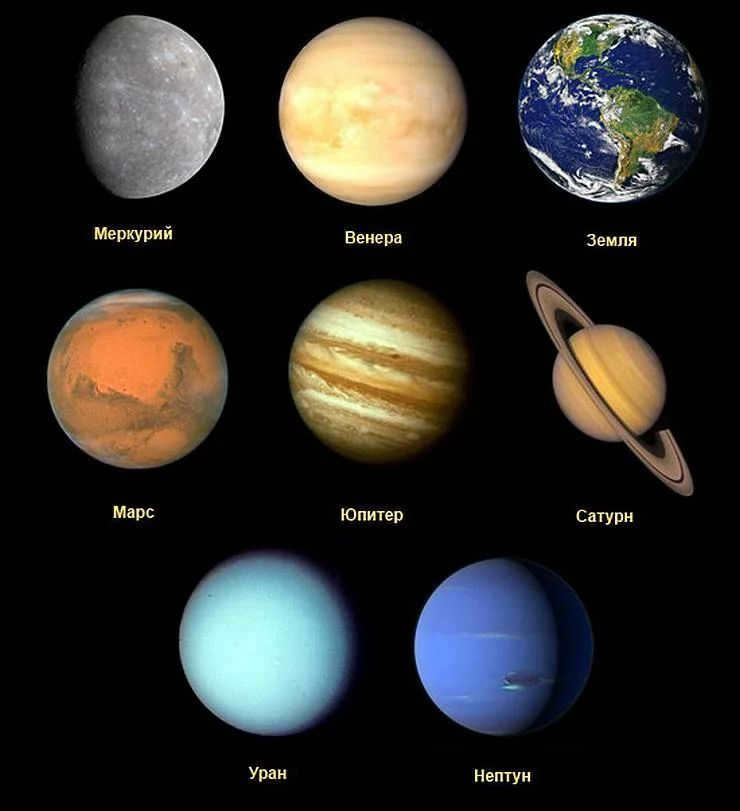
Mercury
Mercury, the planet closest to the Sun and the smallest planet in our solar system, is just a little bit bigger than the Moon. It receives seven times more heat and light than Earth, which means that its surface temperature can range from a scorching +430°C during the day to a freezing -190°C at night. In fact, this temperature difference is the largest of any planet in our solar system.
Interestingly, Mercury has virtually no atmosphere. Scientists believe that this lack of atmosphere could be due to the intense solar radiation that the planet receives, or it could simply be because a planet of this size is unable to hold onto a dense gas envelope.
Because Mercury has a much smaller orbit around the Sun compared to Earth, its year is much shorter – only 88 Earth days. In fact, more than two local years pass in just one day on Mercury. Additionally, since the planet’s axis of rotation is almost not tilted, it does not experience distinct seasons like Earth does.
Venus
Venus, also known as the second planet from the Sun and the closest to Earth, is often referred to as our planet’s “twin” due to its similar size and mass. However, the similarities between Venus and Earth end there.
Venus is enveloped in an incredibly dense layer of clouds, making it impossible to see its surface. The greenhouse effect on Venus causes the planet to heat up to a scorching 480°C, setting an absolute record within our solar system. Additionally, the clouds on Venus release acid rain and only allow 40% of sunlight to penetrate, resulting in a perpetually gloomy atmosphere.
Unlike any other planet, a day on Venus lasts longer than its year, with a duration of approximately 243 Earth days. In contrast, a year on Venus is slightly shorter, lasting about 225 Earth days. Similar to Mercury, Venus does not experience any distinct seasons.
Venus has the ability to reflect sunlight effectively, which gives it a brilliant appearance in the Earth’s sky compared to other planets. This may be the reason why the ancient Romans correlated Venus with the goddess of love and beauty. Interestingly, Venus is one of the two planets in our solar system that rotates in a clockwise direction around its axis.
Planet Earth
Planet Earth is positioned as the third celestial body from the Sun and stands out as the largest within the Earth group. The distinct and unparalleled conditions present on Earth have facilitated the development and evolution of life on this planet.
Earth’s atmosphere consists predominantly of nitrogen, making up approximately 78% of its composition, with oxygen following closely at 21%. Additionally, the atmosphere contains a small percentage of carbon dioxide and other gases, collectively constituting 1%. Both oxygen and nitrogen play crucial roles in the construction of DNA. Furthermore, the ozone layer, found within Earth’s atmosphere, serves as a protective barrier, effectively absorbing solar radiation. Plant life on Earth has the remarkable ability to synthesize oxygen through the process of photosynthesis, converting carbon dioxide into this vital gas. The presence of these plants is imperative, as without them, our planet would resemble Venus. On the other side of the spectrum, a certain amount of carbon dioxide in the atmosphere is necessary to maintain Earth’s temperature at a level suitable for sustaining life.
Approximately 70% of Earth’s surface is covered by water. In contrast to the Moon and Mercury, Earth displays a limited number of craters. Scientists hypothesize that these craters have eroded over time due to wind and soil erosion, resulting in their scarcity.
The Moon, which is the Earth’s satellite, has a diameter that is a quarter of the Earth’s diameter, making it comparatively large for a satellite. The gravitational pull of the Moon influences the Earth’s bodies of water, resulting in the occurrence of tides. Notably, the Moon’s rotation on its axis and its orbit around the Earth are synchronized, resulting in the Moon consistently presenting only one side towards the Earth.
Mars
Mars, the fourth planet in our solar system, is approximately half the size of Earth. For a considerable period of time, it was hypothesized that Mars harbored life. People observed formations on its surface that appeared to resemble buildings, roads, and even colossal sculptures. However, these observations were ultimately proven to be optical illusions. Despite numerous research missions, no evidence of life on Mars has been discovered.
The atmosphere of Mars shares a similar composition to Venus, consisting of about 95% carbon dioxide. However, due to its thin and rarefied nature, there is no greenhouse effect, resulting in a maximum surface temperature of around 0°C and atmospheric pressure 160 times lower than that of Earth. While the Martian atmosphere does contain water vapor and polar ice caps, liquid water does not exist on its surface.
Due to its greater distance from the Sun, the length of a year on Mars is nearly double that of Earth. The rate of rotation around its axis is nearly identical to that of Earth, resulting in a day that lasts 24 hours and 40 minutes. Mars has a tilt of 25.2°, allowing for the presence of seasons, similar to Earth.
Mars is accompanied by two satellites, Phobos and Deimos, which are irregularly shaped rocks of relatively small size. The planet was named after the Roman god of war due to its distinct red coloration.
Jupiter
Jupiter, the largest planet among the giants, is located beyond Mars, separated by a belt of asteroids. With a mass twice that of all other planets, moons, comets, and asteroids combined, Jupiter is only surpassed by Venus in terms of brightness in our Earth’s sky. From ancient times, people have observed Jupiter and associated it with the most powerful deities in their respective pantheons. The name Jupiter comes from the Roman god, who was the ruler of all gods.
Jupiter is classified as a gas giant. The planet’s atmosphere is characterized by swirling clouds of sulfur compounds, creating brown and white streaks that move at incredible speeds. One of Jupiter’s most famous features is the “Big Red Spot,” a massive vortex.
Saturn, the sixth planet in our solar system, is located at a considerable distance from the Sun. Its atmosphere is composed mainly of hydrogen (96%) and helium (4%), with small amounts of other gases mixed in. The winds on Saturn are incredibly strong, reaching speeds of up to 1,800 km/h, making them the most powerful in the entire solar system. Within Saturn’s atmosphere, there are also distinctive patterns of clouds, including streaks and patches of giant vortices, although they are not as prominent as those found on Jupiter.
Due to its distance from the Sun, Saturn takes approximately 29.5 Earth years to complete one orbit around it. Interestingly, the tilt of Saturn’s axis is similar to that of Earth’s. Moreover, Saturn is known for its rapid rotation, second only to Jupiter in speed. This is because Saturn’s surface is not solid but fluid, like other gas giants. In fact, Saturn’s density is so low that it is believed to be less dense than water and could theoretically float on its surface.
One of Saturn’s most notable characteristics is its magnificent set of seven rings. Composed of countless icy fragments that reflect light with exceptional clarity, these rings are incredibly prominent. Spanning a distance of 73,000 kilometers and measuring a mere 1 kilometer in thickness, the rings are hypothesized to be remnants of a satellite that was torn apart by the immense gravitational force of the planet.
Uranus
Uranus is the seventh celestial body from our Sun. It has a distinctive blue-green hue due to its atmosphere, which scientists believe is caused by the presence of methane. The cores of Uranus and Neptune are commonly referred to as “ice giants” because they are believed to be primarily composed of ice. With an average surface temperature of -224°C, Uranus holds the title for being the coldest planet in our solar system. The winds on Uranus can reach incredible speeds of up to 900 km/h. It takes approximately three hours for sunlight to travel from the Sun to Uranus, and a single year on this planet is equivalent to 84 Earth years.
Similar to Saturn, Uranus is encompassed by rings. These rings are not as vibrant and are positioned at an approximately 90° angle to the planet’s orbit. Interestingly, Uranus itself rotates “sideways” with an axis tilt of 99°. Consequently, half of the Uranian year experiences daytime in the southern hemisphere and nighttime in the northern hemisphere, while the other half reverses this pattern.
Just like Venus, Uranus also rotates in a clockwise direction on its axis. At present, there are 23 known icy satellites orbiting Uranus.
Data on Neptune was reliably obtained by Voyager 2 back in 1989. Neptune’s upper atmosphere is composed of hydrogen (80%), helium (19%), and methane (1%). It is the high presence of methane that accounts for the planet’s striking blue hue.
Periodically, dark storm spots come and go within Neptune’s atmosphere. It is believed that Neptune has an icy core at its center, while the mantle is made up of a liquid mixture of water and ammonia. The average temperature on the planet’s surface is a chilling -214°C.
It takes nearly 5 hours for sunlight to reach Neptune, and a Neptunian year is equivalent to 165 Earth years. The planet completes a full rotation on its axis quite swiftly, with a day lasting just 17 hours. The tilt of Neptune’s axis is similar to Earth’s, at 28°.
Currently, there is a knowledge about 14 satellites orbiting Neptune, with only one (Triton) possessing a spherical form. Triton is also unique as the largest satellite in the system with a retrograde rotation. In addition, Neptune is surrounded by three rings, although their visibility is quite faint.
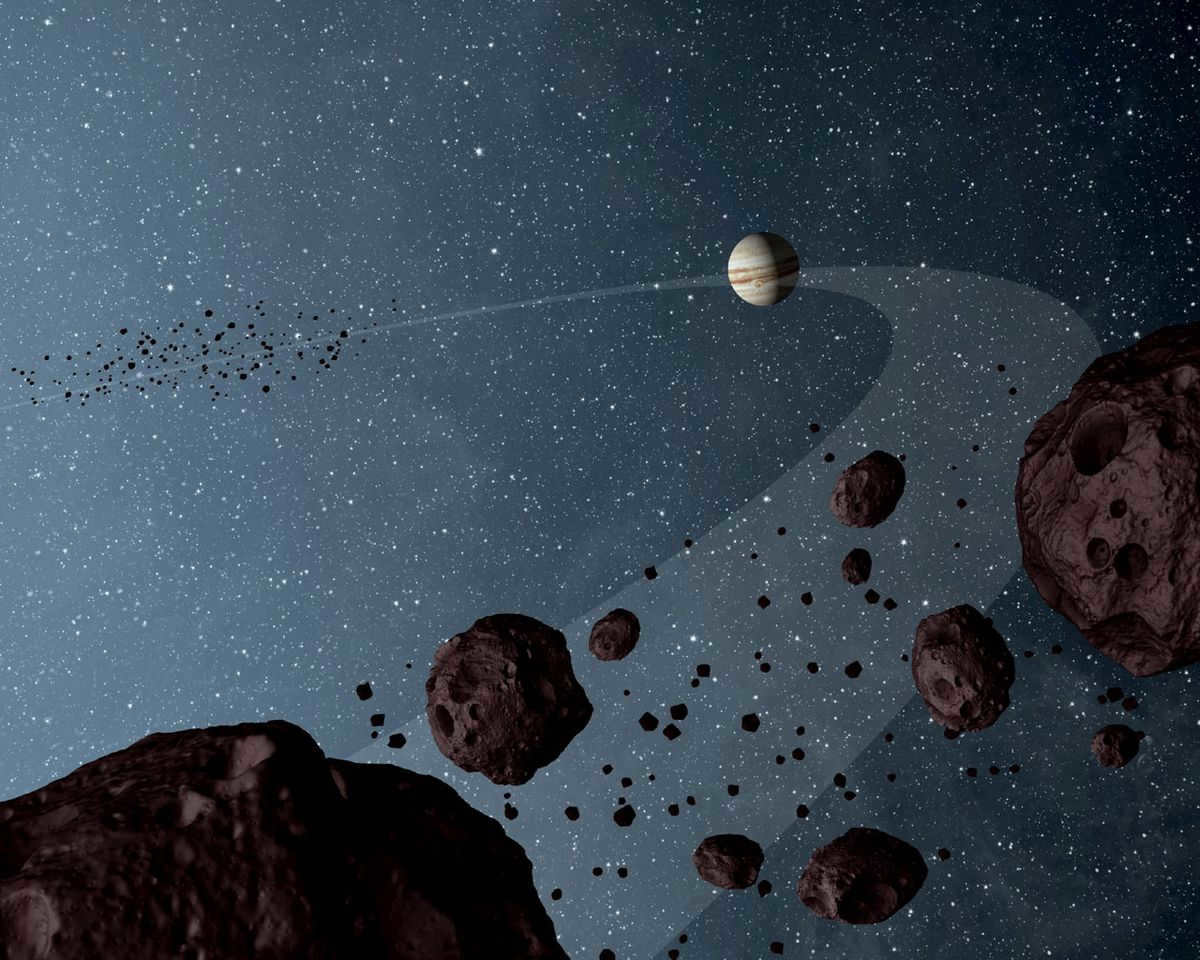
Space objects that cannot be classified as dwarf planets, planets, or their satellites are known as small bodies of the solar system. This category includes comets, bolides, meteorites, asteroids, centaurs, damocloids, interplanetary gas, and dust.
Comets
Comets are celestial objects that travel in elongated orbits. They consist of frozen gases and cosmic dust.
The shapes of comet tails are usually indistinct and somewhat see-through. Astronomers have currently documented 6,339 comets that are situated close to planets or within the inner part of the solar system.
Asteroids, which lack atmosphere and have an irregular shape, are smaller celestial bodies that orbit the Sun and are inferior in both size and mass to planets. The majority of asteroids are found in the region between the orbits of Mars and Jupiter, known as the asteroid belt. Notable examples of asteroids include the dwarf planet Ceres, as well as Pallada, Vesta, and Hygeia.
Dwarf planets
A dwarf planet is a celestial body that, although not classified as a satellite, lacks the ability to clear its orbit of other objects. It orbits the Sun and possesses enough mass to maintain a spherical shape. Scientists have identified over 40 celestial bodies that meet the criteria for being classified as dwarf planets. However, only a handful have been officially recognized as such, including Pluto, Haumea, Erida, Makemake, and Ceres.
Interstellar Dust
Interstellar dust refers to cosmic dust particles that have sizes ranging from 2-3 molecules to 0.2 microns. The composition of dust can be categorized into several types, including comet dust, asteroid dust, and dust from the Kuiper belt, which is a region located beyond Neptune’s orbit. Additionally, the comparison of particle characteristics indicates the existence of interstellar dust that traverses through our solar system.
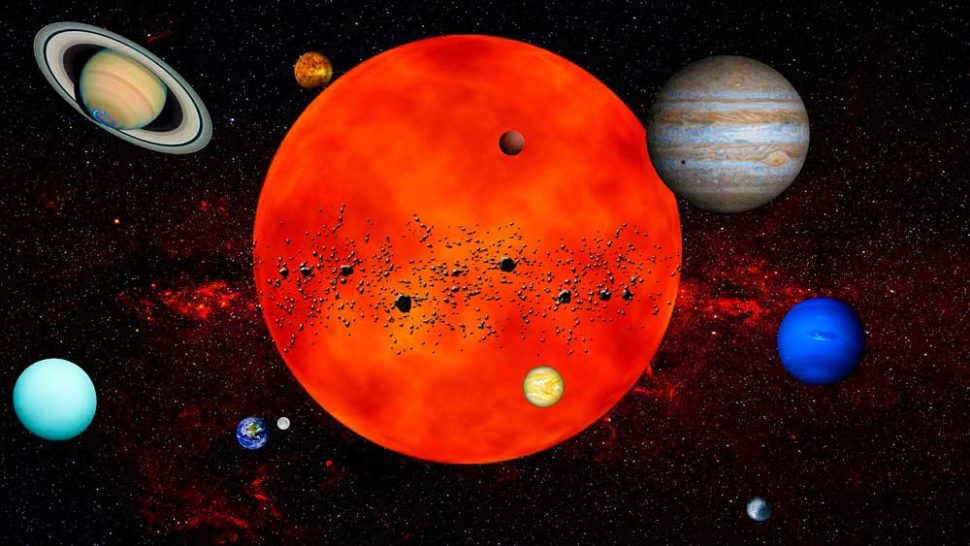
The solar system is a collection of celestial bodies, including the Sun and various other astronomical objects that orbit around it. These bodies consist of planets, moons, asteroids, and other entities. While the solar system is not unique, numerous other planetary systems have been identified thus far. Situated within the Milky Way galaxy, the solar system is positioned in a specific region known as the Orion Arm.
Defining the exact boundaries of our planetary system remains a topic of debate among scientists. Some experts argue that the impact of the solar wind on interstellar space should be considered. Where the solar wind encounters interstellar matter and is halted, a boundary known as the heliopause is formed. This heliopause is located approximately 113 to 120 astronomical units (a.u.) away from the Sun.
Nevertheless, there are astronomers who also differentiate the gravitational boundary of our solar system, known as Hill’s sphere. This region defines the extent of space where the gravitational pull of the Sun is dominant over the gravitational pull of other stars. In the case of our Sun, this sphere has a radius equivalent to approximately one light-year or 63 thousand astronomical units (a.u.).
Formation and makeup
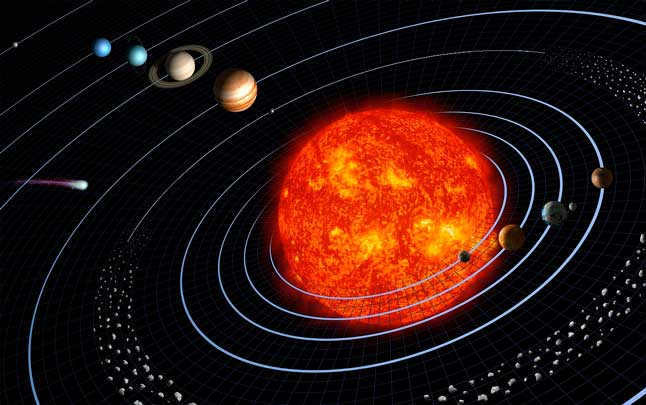
The Sun is the central celestial body within the solar system and constitutes an overwhelming 99.86% of its total mass. Currently, there are eight planets orbiting around this luminous entity. Among these, the closest four planets resemble Earth in terms of their characteristics, while the subsequent four are classified as gas giants. Positioned between these two groups is the main asteroid belt, known for its abundance of asteroids. Additionally, beyond Neptune’s orbit, the outermost gas giant, lies another cluster of asteroids known as the Kuiper belt.
In 2006, a new phrase, dwarf planet, was brought forth. These celestial bodies are akin to typical planets, but they possess the distinctive characteristic of harboring other sizable objects within their orbit. As of 2019, there have been 5 entities bestowed with the classification of dwarf planets, yet experts in astronomy posit that there may exist a substantially larger number.
Within planetary systems, one can also find satellites revolving around the planets. A few of these satellites, such as Ganymede and Titan, are of such considerable dimensions that they surpass the magnitude of Mercury, the smallest of the planets.
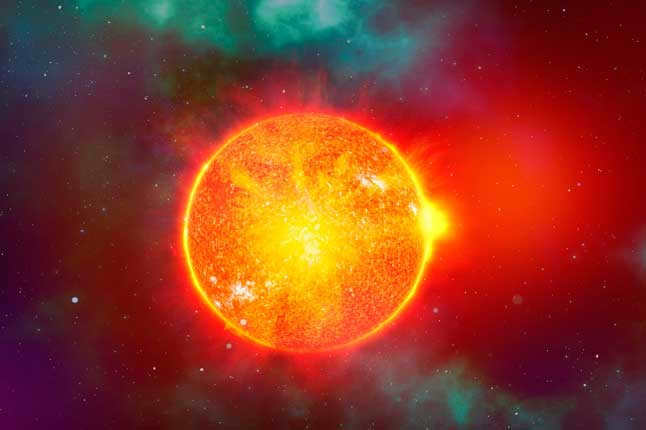
The Sun is just one of the numerous stars within the Milky Way galaxy. With a diameter of approximately 1.4 million kilometers, it surpasses the Earth’s diameter by over 100 times. The Sun’s mass is estimated to be between 2 and 10^30 kilograms, an immense value that is 333,000 times greater than the Earth’s mass.
While the surface temperature of the Sun measures 5500°C, there exists a region above the surface known as the corona. Interestingly, the temperature of the corona can soar up to 1.5 million degrees Celsius. The mechanism responsible for this extraordinary heating of the solar corona remains unknown.
At the core of the star, there is a central region with a diameter of 300,000 km. The temperature in this area is estimated to be around 13.5 million degrees, while the pressure reaches an astonishing 200 billion atm. These extreme conditions are crucial for the process of fusion. During fusion, hydrogen atoms combine and transform into helium, releasing a significant amount of heat. This fusion process serves as the primary source of heat for the entire solar system.
Currently, the Sun is composed of 73.4% hydrogen and 24.9% helium. It is evident that as a result of thermonuclear fusion, hydrogen is gradually depleted (over 4 million tons of hydrogen are consumed every second), leading to a decrease in its proportion within the star’s composition over time.
The celestial bodies of the solar system

The ecliptic is the plane in which the Earth’s orbit is located. It is accurate to say that the orbits of all the other planets also lie in this same plane, with a maximum deviation of 7 degrees observed for Mercury. Additionally, all the planets rotate in the same direction, providing indirect evidence that the entire matter of the solar system was once a single entity.
Not only do planets orbit around the star, but they also spin on their own axis. It is commonly accepted that 1 orbit around the star is equivalent to a year on the planet, while one rotation on its own axis is equivalent to a day. As a result, a day on Jupiter lasts approximately 10 hours, and a year on Jupiter is approximately 11.86 Earth years.
The terrestrial planets
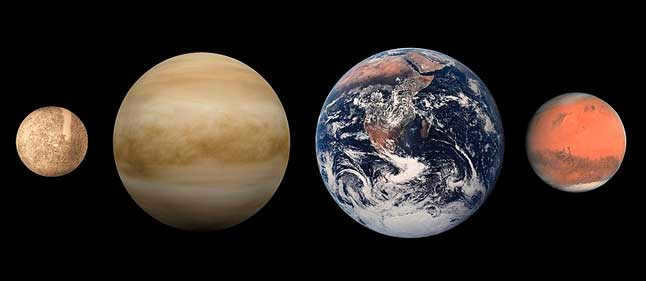
The planets belonging to the Earth group share a common characteristic – they possess a solid outer layer that is immediately followed by an atmosphere. These planets are relatively small in size and typically have very few or no natural satellites. Unlike Saturn, they do not possess rings. Composed primarily of solid rock and heavy elements such as oxygen, iron, and silicon, each planet in the Earth group is believed to have a metallic core surrounded by a mantle dominated by silicon. On the surface, however, there exists a relatively thin crust.
Mercury is the planet that is closest to the Sun, and its average distance from the Sun is about 58 million kilometers. Additionally, it is the smallest and fastest planet in our solar system. It takes approximately 87.969 Earth days for Mercury to complete one orbit around the Sun, while a day on Mercury lasts about 58.646 Earth days. Interestingly, for every 2 orbits that Mercury completes around the Sun, it also completes exactly 3 rotations on its own axis. The radius of Mercury is approximately 2439.7 kilometers, and its mass is estimated to be about 0.055 times the mass of the Earth. Unlike some other planets, Mercury does not have any natural satellites orbiting around it.
Venus
Venus is the planet that follows the Sun in our solar system. It is often referred to as the “Earth’s sister” due to its similar size. Venus has a radius of 6050 km, which is 95% of the Earth’s radius. The planet’s mass is 18.5% less than that of Earth. Venus is located at a distance of 107.5 to 108.2 million kilometers from the Sun. Despite being closer to the Sun than Earth, Venus is actually hotter than Mercury. Its average temperature is around 477 degrees Celsius, with minimal fluctuations. This high temperature is attributed to Venus’ dense atmosphere, which is composed of 96% carbon dioxide. The atmospheric density is so extreme that the surface pressure on Venus reaches 93 atm. If Venus had an atmosphere similar to Earth’s, its temperature would not exceed 80 degrees Celsius. Unlike Earth, Venus does not have any natural satellites. However, there is a theory that suggests Mercury may have once had a satellite.
Planet Earth
Planet Earth, the place where humanity originated, is the third planet in our solar system. Its distance from the Sun varies between 147 and 152 million kilometers. The average distance, which is approximately 149.6 million km, is commonly used in astronomy as a unit of measurement known as the astronomical unit (a. e.). With an average radius of 6371 km, Earth is part of the terrestrial group of planets. It has a mass estimated at 5.97-10 24 kg. One distinctive feature of Earth is its large satellite, the Moon, which has a radius of 1737 km.
Mars
Mars is the final planet in our solar system that resembles Earth in many ways. Its distance from the Sun can vary, ranging from 206 to 249 million kilometers. The Red Planet has a smaller mass compared to Earth, being just one-tenth of its size, and its radius measures 3389.5 kilometers. A Martian day lasts for 24 hours and an additional 37 minutes, while a Martian year is equivalent to 687 Earth days. Mars is accompanied by two small satellites, Phobos and Deimos, although they are significantly smaller than our Moon. The largest of the two, Phobos, has an irregular shape and measures 26.8×22.4×18.4 kilometers in size.
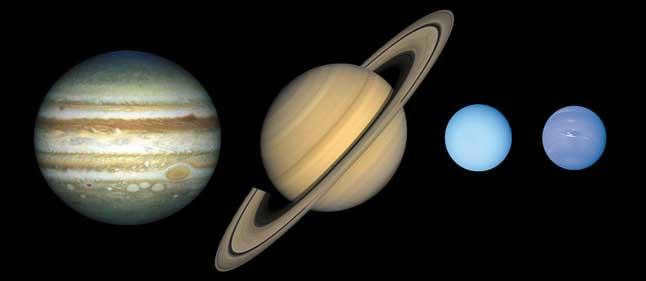
The gas giants are the outer planets of our solar system. They are enormous in size compared to Earth and lack a solid surface for potential human landing. The majority of these planets are composed of an atmosphere that transitions into a liquid state due to increased pressure at lower altitudes. There is no distinct boundary between the liquid ocean and the atmosphere, and below the ocean lies a solid core under even higher pressure.
Hydrogen is the primary element found in the giant planets, ranging from 80% in Neptune to 96% in Saturn. Helium is the second most abundant element, while all other elements account for no more than 1-3%.
Each gas giant possesses numerous satellites, some of which are larger than dwarf planets. Additionally, all gas giants have rings surrounding them, with Saturn’s rings being the most prominent.
Jupiter
Jupiter is the gas giant nearest to the sun. It is the second largest object in our solar system, with an estimated average radius of 69,911 kilometers. Its mass is 318 times greater than that of Earth. A year on Jupiter lasts 11.86 Earth years, and it completes a full rotation on its axis in just 10 hours. Jupiter’s orbit has a radius ranging from 740 to 816 million kilometers. As of now, scientists have confirmed the existence of 79 satellites orbiting Jupiter, but the actual number is likely to be over 100. Notable among these satellites are Ganymede, Io, Europa, and Callisto, which were first observed by Galileo in 1610 and were the first satellites of other planets to be discovered by astronomers.
Saturn
Located beyond Jupiter’s orbit, Saturn is a planet with impressive dimensions. It has an estimated radius of 58,232 kilometers and a mass equivalent to 95.2 times that of Earth. The distance between Saturn and the Sun varies throughout its elliptical orbit, with its perihelion being approximately 1.353 billion kilometers away, and its aphelion at a distance of about 1.513 billion kilometers. Unlike Jupiter, which rotates swiftly, a day on Saturn lasts a bit longer, with a duration of 10 hours. As for its orbital period, Saturn takes approximately 29.5 Earth years to complete one revolution around the Sun. As of 2019, scientists have identified a total of 82 satellites orbiting the planet, with the largest one being Titan, which has a radius of 2,576 kilometers. One fascinating aspect of Titan is the presence of lakes and rivers on its surface. However, these bodies of liquid are not filled with water but rather with methane and ethane.
Uranus
Uranus, the following celestial body in our solar system, has a varying distance of 2.75 to 3 billion km from the Sun. With a radius of 25362 km, Uranus possesses a mass that is 14.5 times greater than that of Earth. A single rotation on Uranus takes approximately 17 hours, while a complete orbit around the Sun takes 84 Earth years. As of now, Uranus boasts a total of 27 satellites, the most prominent of which is Titania, measuring 788 km in radius.
Neptune is currently the most distant planet in our solar system. It is situated approximately 1.45-4.52 billion kilometers away from the Sun. The mass of Neptune is 17.1 times greater than that of Earth, and its radius measures 24622 km. A day on Neptune lasts almost 16 hours, while a year is equivalent to 164.79 Earth years. Similar to Uranus, Neptune falls under the category of ice giants, which are a unique class of gas giants. These ice giants, much smaller in size compared to Jupiter and Saturn, consist mainly of ice, methane, ammonia, and hydrogen sulfide. In total, Neptune has 14 moons, with Triton being the largest among them. Triton measures approximately 1,353 kilometers in radius.
The planet number nine
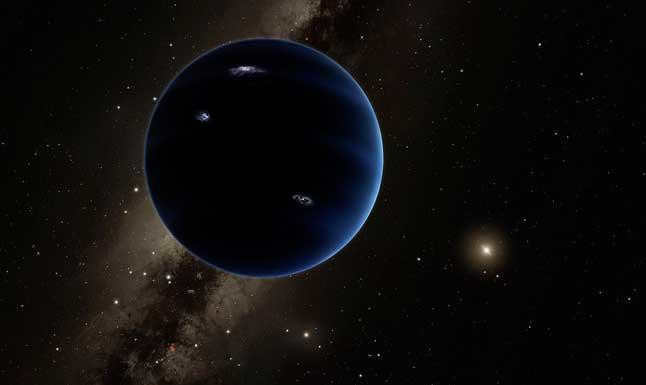
The confirmation of the existence of the Ninth Planet can only be achieved through visual observation, as calculations do not provide any assistance in estimating its location with even a moderate level of accuracy. Currently, only the approximate orbit of this celestial body is known. Given its considerable distance from Earth and its relatively slow speed of movement, detecting the Ninth Planet proves to be an exceedingly challenging task.
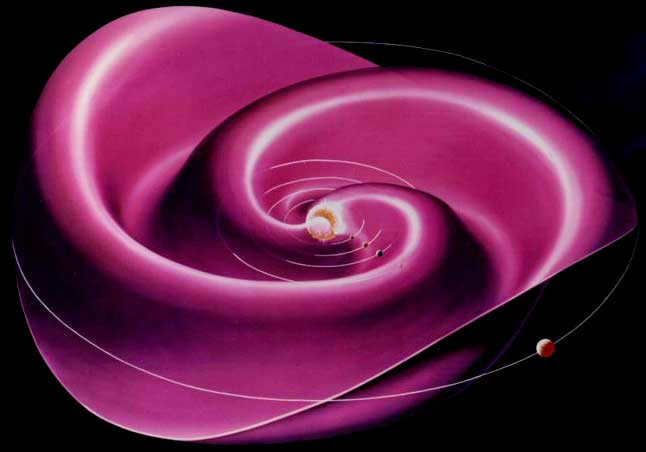
There is still no agreement on the exact location of the border between a planet’s atmosphere and interplanetary space (outer space). For Earth, it is widely accepted that this border is either 100 or 122 km.
The Sun releases a continuous stream of particles known as the solar wind. This is what fills the interplanetary space within our solar system. The solar wind consists of electrons, protons, and other ions. This wind actively erodes the atmospheres of Venus and Mars, causing these planets to gradually lose their atmospheric layers. However, Earth’s atmosphere is shielded from the solar wind by a robust magnetic field.
Additional items
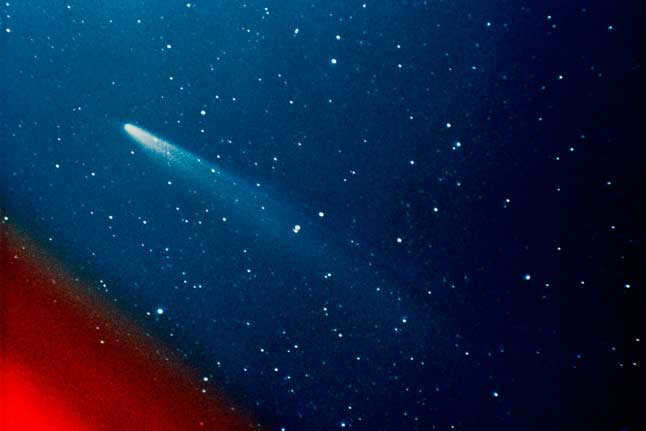
All dwarf planets, with the exception of Ceres, can be found within the Kuiper Belt, which is a collection of asteroids that exists beyond the orbit of Neptune. There is also another belt of asteroids known as the main asteroid belt, which is situated between Mars and Jupiter. This is where Ceres is located. The main asteroid belt earned its name because objects within it were discovered much earlier than those in the Kuiper Belt. For instance, Ceres was first observed in 1801, whereas Pluto was not discovered until 1930. However, it is important to note that the total mass of objects within the Kuiper Belt is estimated to be 20-200 times greater than that of the main belt.
Scientists have identified a separate group of asteroids that reside between the orbits of Jupiter and Neptune. These asteroids are referred to as centaurs. The largest known centaur, Chariklo, has a radius of 129 km.
There is a speculation that there might exist another group of celestial objects beyond the Kuiper belt, known as the Oort cloud, located at a distance of 50-100 thousand a.u. The Oort cloud is approximately 1000 times farther than the Kuiper belt. Currently, there have been only 5 discovered bodies that could potentially belong to the Oort cloud.
The creation and development of the solar system
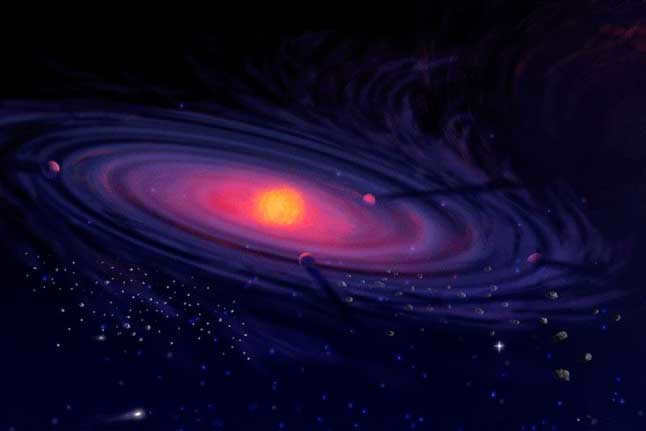
Currently, the dominant theory in science is the nebular hypothesis, which suggests that the solar system was formed from a cloud of gas and dust. This process started approximately 4.57 billion years ago. As a result of gravitational forces, the particles in this cloud were attracted to each other, causing the cloud to gradually shrink in size. Simultaneously, its rotation speed increased, leading to an increase in the density of matter, temperature, and pressure at the center.
After around 50 million years, the hydrogen concentration and temperature at the center of the cloud reached levels that initiated thermonuclear fusion. This is how the Sun came into existence.
The planets that formed in close proximity to the sun were heated by its intense heat, preventing substances like water, ammonia, and methane from solidifying. On the other hand, the giant planets were created further away from the star, where temperatures were so frigid that these substances became solid.
Initially, the Earth was extremely hot and lacked a solid crust. The denser materials sank towards the center of the molten Earth, while the lighter substances rose to the surface. As time passed, the Earth gradually cooled, leading to the formation of a solid crust. Similar processes occurred on other Earth-like planets.
Scientists believe that the Moon formed as a result of a collision between Earth and another planet named Teia. This collision caused some of Earth’s matter to be ejected into space, eventually coalescing to form a satellite orbiting our planet.
Thermonuclear reactions occurring within the Sun are undergoing acceleration, leading to a gradual increase in its luminosity at a rate of approximately 10% per billion years. This ongoing process is predicted to persist for a total duration of 3.5 billion years, ultimately culminating in a remarkable 40% surge in brightness.
Following this phase, the Sun will eventually deplete its hydrogen supply, which is estimated to transpire in approximately 7.7 billion years. At this point, the Sun will undergo a transformation into a red giant, characterized by a significant expansion in size. Consequently, the Sun will engulf both Mercury and Mars, and there is a possibility that Earth will also be consumed in the process. As time progresses, the Sun will then transition into a white dwarf, subsequently evolving into a black dwarf. Concurrently, it will gradually diminish in size and cease emitting heat to its surroundings.
Exploration and investigation
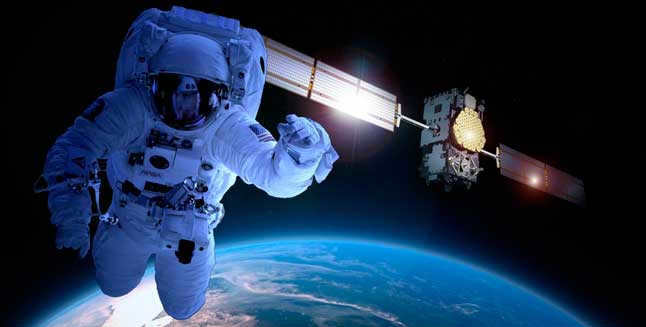
Ancient civilizations such as the Egyptians, Sumerians, Chinese, and Mayans were the first to have knowledge of the solar system. They observed the sky and discovered the existence of the initial six planets. It was evident to them that the Sun revolved around the Earth, leading to the geocentric model of the solar system. According to this model, the Earth was believed to be at the center, while the planet’s trajectories were complex, with some of them even reversing their movements.
In 1781, William Herschel made a significant discovery by finding Uranus, the seventh planet. The year 1801 marked the discovery of the first asteroid, Ceres.
Calculations revealed that Uranus did not adhere to the expected orbit based on Newtonian mechanics. This led to the assumption that there must be another planet beyond Uranus, which was later named Neptune. It was first theorized in 1846 and visually observed by Johann Galle.
Pluto, discovered in 1930, was initially considered the tenth planet. However, further observations revealed that it shared its orbit with other celestial bodies. In 1992, the existence of the Kuiper Belt, which includes Pluto, was proven. In the early 2000s, several celestial bodies within the Kuiper Belt, including Pluto, were classified as dwarf planets in 2006.
The progress of space exploration has played a significant role in studying the solar system. In 1959, the Soviet Luna-1 spacecraft successfully overcame Earth’s gravitational pull and conducted the first-ever survey of the Moon. Following that, spacecraft have been dispatched to all the planets in our solar system, as well as several satellites, asteroids, and comets. “Voyager 1, which was launched in 1977, is presently investigating the heliopause region.”
The Moon remains the only celestial body in the solar system where humans have set foot. A total of six manned missions were carried out on the Earth’s satellite between 1969 and 1972.
Fascinating trivia
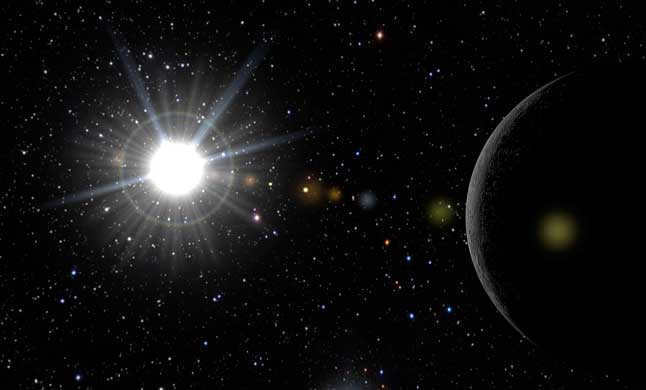
An interesting occurrence referred to as the Joshua phenomenon can be witnessed on the planet Mercury. This phenomenon occurs when the planet is near perihelion, causing its rotation around the star to surpass its rotation around its own axis. As a result, observers on the planet will perceive the Sun to move across the sky in the opposite direction. It may even appear to rise and set in different locations. The name of this phenomenon is derived from the biblical story of Joshua, who was said to have halted the movement of the Sun.
In July 1994, astronomers witnessed the historic event of two celestial bodies in our solar system colliding. Jupiter was struck by Shoemaker’s Comet Levi 9, which was comprised of 21 fragments, each approximately 2 kilometers in diameter. This collision emitted an extraordinary amount of energy, estimated to be equivalent to 6 trillion tons of TNT.
Out of the eight planets in our solar system, six of them rotate on their axes in the same direction as they revolve around the Sun. However, Venus and Uranus are the exceptions to this rule. Venus rotates in the opposite direction, while Uranus has its axis almost aligned with the plane of the ecliptic. Consequently, each pole of Uranus is exposed to sunlight for a period of 42 years, followed by 42 years of darkness.
In 1921, the rings of Saturn disappeared abruptly. Concerns arose in the media about the possibility of particles from these rings heading towards Earth. In reality, the rings were simply tilted towards Earth, rendering them invisible.
Video
List of utilized sources
– https://en.wikipedia.org/wiki/Solar_system
– https://spacegid.com/planets-of-our-solar-system.html#i-8
– https://v-kosmose.com/journey-through-the-solar-system/
– http://solarviews.com/eng/solarsys.htm
– https://www.nationalgeographic.com/science/space/our-solar-system/
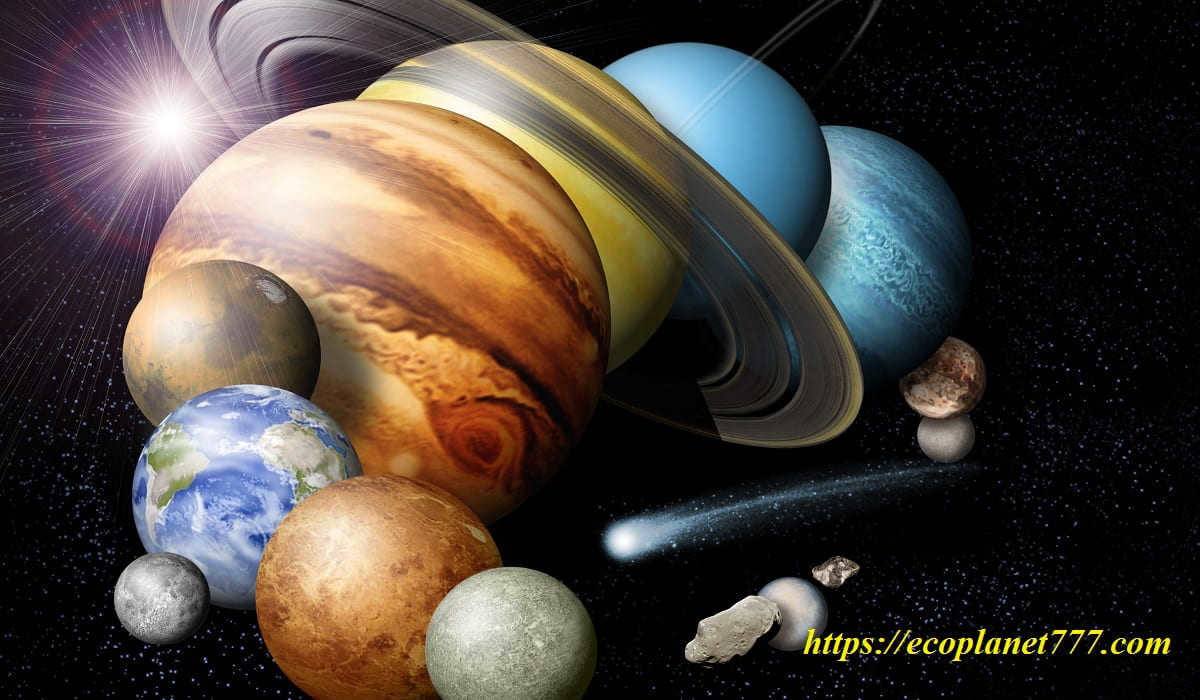
A planet is a celestial body that orbits a star and has sufficient mass to achieve hydrostatic equilibrium, where the force of gravity is balanced by the energy produced by its core. This equilibrium allows the planet to maintain a spherical shape and dominate its orbit, preventing other bodies from interfering with its trajectory.
Our planet Earth, along with the other seven planets in the solar system, revolves around the Sun. While they all possess the characteristics that define them as “planets,” they differ from one another based on their composition and location within the solar system.
To learn more about the organization and structure of the Sun, click here.
Characteristics of Planets
The composition of the planets in the solar system determines their categorization, which includes:
Terrestrial planets. These planets, also known as “telluric” planets, are characterized by their high density and are primarily composed of rocky and metallic materials. The following planets in our solar system fall into this category: Mercury, Venus, Earth, and Mars.
Gas giants. Also referred to as Jupiterians, these are large celestial bodies that rotate at a much faster rate than Earth. These planets possess dense atmospheres, strong magnetic fields, and numerous satellites. The gas giants in our solar system are Jupiter, Saturn, Uranus, and Neptune.
Fascinating Facts about Planets! Gas giants have a faster rotation speed compared to Earth.
Planets are also classified based on their position in the solar system. In terms of their distance from the Sun, planets are divided into:
Fascinating facts about planets! The outer planets have a remarkably rapid rotation on their axis. For instance, Jupiter completes one rotation in less than 10 hours, Saturn in under 11 hours, Neptune in just over 16 hours, and Uranus in almost 17 hours and a quarter.
Terrestrial planets. These are the planets located closest to the Sun, within the asteroid belt. They include: Mercury, Venus, Earth, and Mars.
Gas giant planets. These are the planets furthest from the Sun, beyond the asteroid belt. They are: Jupiter, Saturn, Uranus, and Neptune.
Solar System’s Planets
Pluto
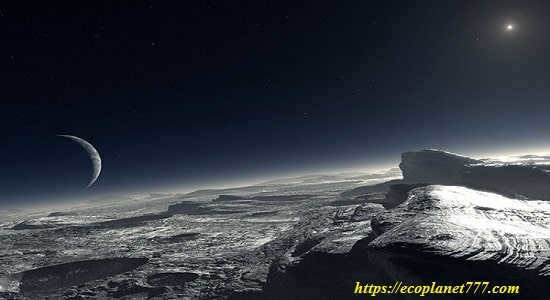
Unearthed in 1930, it was considered a planet until 2006. Following a heated international debate, a decision was made to reclassify Pluto as a “dwarf planet” within the Solar System due to its failure to meet the criteria for being classified as a planet. Unlike planets, Pluto does not have orbital dominance, as its orbit is not clear of other celestial bodies and it possesses five satellites with similar orbits. Pluto is categorized as a rocky outer-type dwarf planet due to its position as the furthest celestial body from the Sun. In addition to Pluto, other dwarf planets have been discovered, including Ceres, Haumea, Makemake, and Eris.
Pluto, the outermost planet in our solar system, holds the title for being the most distant from the Sun. Its extreme distance is so vast that if one were to stand on Pluto’s surface, the Sun would appear merely as a brilliant star in the sky.
With a diameter measuring 2,300 kilometers, Pluto is only half the size of Mercury, the planet that follows it in terms of size. In fact, Pluto is even smaller than some satellites, such as Io, a moon of Jupiter, which boasts a diameter of 3,600 kilometers, or our very own Moon, whose diameter measures 3,470 kilometers.
While most planets adhere to a predictable elliptical orbit in the same plane, Pluto defies convention and follows a highly complex orbit that is distorted to the point of occasionally crossing Neptune’s orbit in a different plane. At certain junctures, Pluto can even appear closer to the Sun than Neptune, only to move away once again.
Planet Earth
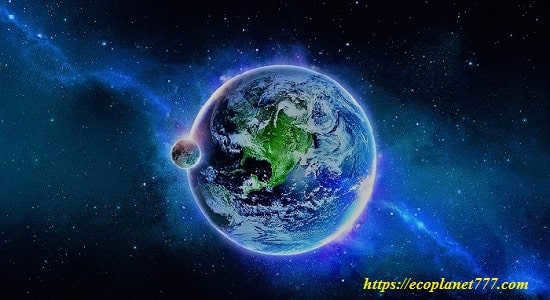
The planet with the highest density in our solar system and the unique presence of water on its surface is Earth. Ranking as the fourth largest planet, it follows Venus and is accompanied by its only natural satellite, the Moon. Earth is the place we call home, and its surface is predominantly covered with vast oceans, giving it a blue appearance when observed from space. This planet stands alone as the only one where water exists in a liquid state.
Additionally, water can be found in the form of small crystals within the clouds of Earth’s atmosphere, contributing to its distinctive white color, combined with hints of blue. Comprised mainly of nitrogen and oxygen, Earth’s atmosphere possesses yet another distinguishing characteristic.
Earth’s atmosphere contains relatively little CO2 compared to Venus and Mars. Initially, this CO2 was dissolved in seawater and consumed by the earliest life forms on Earth. These organisms were small green algae that, as they grew and multiplied, released oxygen into the atmosphere through their metabolic processes.
Geologically, Earth is an extremely active planet. Its crust is composed of large tectonic plates that are constantly shifting due to underground forces. Europe, Africa, and the Americas were once part of a single plate that gradually separated over time. Even today, these plates continue to move apart by a few centimeters each year (according to the Geologic Time Scale).
At the thinnest parts of the Earth’s crust, new crust is constantly being formed beneath the ocean. As a result, these tectonic plates collide in certain regions, causing frequent earthquakes.
If you want to learn more about the Earth’s structure, you can find more information here.
Discover Mercury
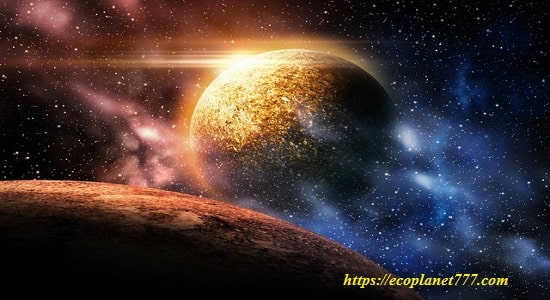
The smallest planet in our solar system, Mercury, has a rocky body that is similar to Earth. What sets it apart is its core, which takes up nearly half of the planet’s volume and generates a strong magnetic field. Unlike other planets, Mercury has no natural satellites. You can catch a glimpse of Mercury within two hours after sunset or before sunrise.
One of the unique characteristics of Mercury is its tilted ecliptic plane, which is more pronounced compared to other planets. Additionally, when Mercury reaches its closest point to the Sun, known as “perihelion,” it is less than two-thirds of its distance from the Sun at its farthest point, called “aphelion.”
Due to its proximity to the Sun, Mercury receives six times more solar radiation than Earth. As a result, the temperature on its sunlit side is incredibly high.
Similar to the Moon, the planet’s surface is covered in craters, which were created by meteorites of various sizes. These craters are a common feature during the early stages of the solar system’s formation.
Due to the absence of erosion caused by the lack of atmosphere, these craters have remained intact, much like on the Moon. It is probable that the planet has never had an atmosphere, as its small size and low gravity would not allow for the retention of a gaseous atmosphere.
Venus
The planet Venus
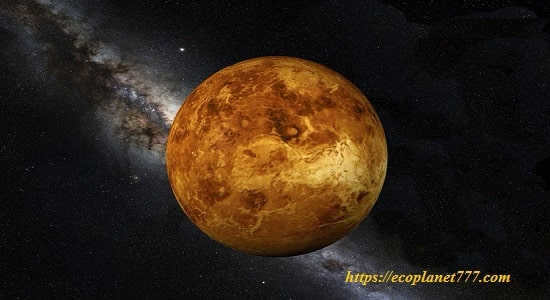
This planet is the third largest in size when counting from smallest to largest. It has a diameter similar to that of Earth and, like Mercury, does not have any natural satellites. Venus is the planet closest to Earth and appears very bright in the sky. Due to its close proximity to the Sun, it can only be seen for a few hours after sunset or before sunrise in the morning.
Due to its size and distance from the Sun, Venus is very similar to Earth. For a long time, it was believed that there might be life on Venus, before its true characteristics were known. Unfortunately, it was later discovered that its surface temperature is 460º C.
The reason for this extreme temperature lies in the planet’s dense atmosphere, which is constantly covered with clouds. Sunlight is able to penetrate the atmosphere and heat the surface, but the heat is unable to escape back into the atmosphere.
The presence of dense cloud cover hinders direct observation. Data relayed by a spacecraft from the planet’s surface indicate that it has a dynamic geology, featuring active volcanoes. The landscape boasts towering mountains comparable in height to Mount Everest, alongside formations that bear a striking resemblance to those found on Earth, encompassing expansive valleys strewn with rocks and peaks. Moreover, discernible depressions on the planet’s surface suggest that they might have once constituted the ocean floor, which subsequently experienced evaporation.
Mars
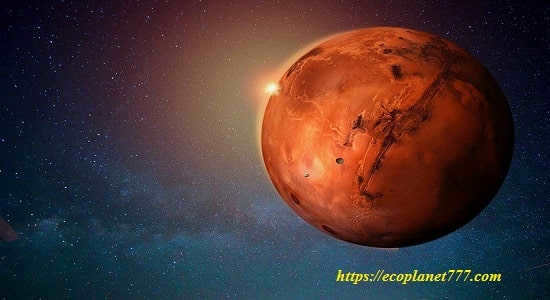
Mars, the second largest planet in our solar system, is commonly referred to as the “red planet” due to its reddish hue caused by iron oxide on its surface. This fascinating planet has two small natural satellites, Phobos and Deimos. Mars has long been associated with the possibility of extraterrestrial life, with the belief that it was once inhabited by beings known as “Martians” who supposedly constructed a network of canals across its surface. However, it is now widely accepted that these canals do not exist and that there is no intelligent life on Mars. The question of whether there has ever been evidence of primitive life on Mars remains a topic of debate. NASA, through the study of Martian meteorites that have made their way to Earth, believes that there may have been traces of primitive life on Mars at some point in its history.
Nonetheless, the fascination with Mars remains strong and humans are making preparations to embark on a journey to the red planet in the not-too-distant future. In fact, Mars has already had a few visitors in the past. Back in 1976, the Viking space probe made a historic landing on Mars, marking the first human-made object to touch the planet’s surface. More recently, a robot was deployed and managed to capture incredibly detailed images of Mars, revealing a landscape of red hues, scattered with pebbles, dust, and rocks. The very atmosphere of the planet also contributes to its crimson appearance, as dust particles float around, casting a reddish hue over the sky.
There are numerous signs that suggest Mars may have shared similarities with Earth in its earlier years, possibly even harboring liquid water on its surface. While the majority of the water on Mars has evaporated, some still remains in the form of ice at the planet’s poles. As the seasons on Mars progress, much like on Earth, the size of the polar ice caps fluctuates accordingly. During Martian summers, the ice extent is reduced, whereas the opposite hemisphere experiences these changes at different times of the year.
Mars possesses an extremely tenuous atmosphere predominantly consisting of carbon dioxide. Enormous dust storms arise on its surface during the changing seasons.
Jupiter
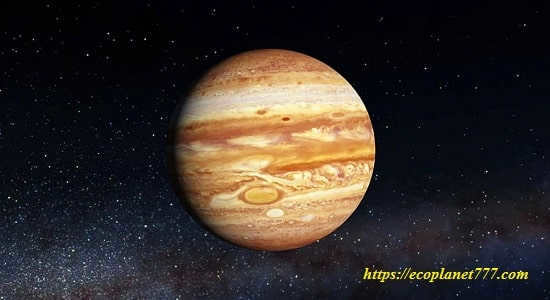
Jupiter, the largest planet in our solar system, is primarily composed of hydrogen and helium. With a diameter ten times that of Earth, it earns its title as the giant of the solar system. Not only does Jupiter boast an impressive size, but its gravitational force is also immense, capable of influencing the movement of other planets and even altering the paths of comets that come near its orbit.
Internally, Jupiter is predominantly made up of hydrogen and some helium, both in liquid form due to the intense pressure caused by its atmosphere. Deeper within the planet, the pressure becomes so extreme that the hydrogen transitions into a metallic state. At the core of Jupiter lies a small rocky center. Closer to its visible surface, where the pressure is lower, the hydrogen exists as a gas, forming the planet’s atmosphere.
When observing Jupiter from Earth, one can notice the banded structure of its atmosphere as well as large red patches that resemble cyclones. These patches are primarily located in the southern hemisphere.
Another interesting feature of Jupiter is its ring, which is composed of numerous particles. The inner circle of this ring is situated close to the first clouds of Jupiter’s atmosphere.
The four largest satellites of Jupiter are commonly referred to as “Galileo’s satellites” because they were discovered by Galileo himself using his primitive telescope. These satellites were extensively studied by the Voyager probe, providing us with highly accurate images of each of them.
The four largest moons (known as Galileo’s moons) were given the names Io, Europa, Ganymede, and Callisto. Io is slightly larger than our Moon, while Europa is slightly smaller. Ganymede, on the other hand, is slightly larger than the planet Mercury, while Callisto is slightly smaller. Each moon possesses its own unique characteristics. For instance, Io exhibits a vibrant mix of red, yellow, orange, and white hues, which are the result of sulfur eruptions from its active volcanoes. Europa, on the other hand, boasts a shiny surface that appears to be covered in a layer of ice. This particular characteristic has fascinated scientists, as it suggests the possibility of primitive life existing beneath its icy exterior. Ganymede, in contrast, has a mottled appearance, with bright spots formed by meteorite impacts on its icy cap. Lastly, Callisto showcases a dark surface and is believed to be composed of a combination of rocky material and ice. It also bears a multitude of craters on its surface.
Saturn is a unique planet in our solar system.
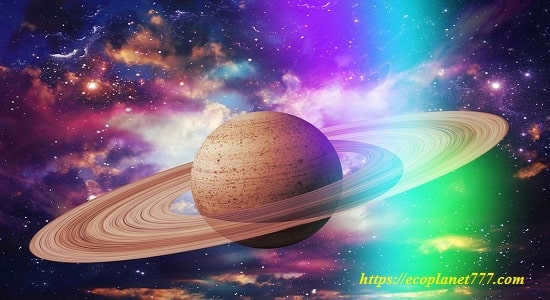
Saturn is the second largest planet in our solar system, coming in just behind Jupiter. What makes Saturn truly unique is its planetary rings, which consist of dust and other small particles that orbit around the planet. Scientists have discovered sixty-one satellites orbiting Saturn, but it is believed that the actual number could be closer to two hundred. The most striking feature of Saturn is undeniably its magnificent rings, which add to its overall beauty. Compared to Jupiter, Saturn is slightly smaller and lacks the same vibrant colors. The cloud belts on its surface are blurry, making it difficult to observe any significant details. The planet is primarily composed of hydrogen and helium gas.
The remaining four satellites that are remarkable for their size include Rhea, Lapetus, Dione, and Tefia. These satellites have a diameter of approximately 1,000 kilometers and bear a striking resemblance to the Galilean satellites of Jupiter.
Uranus
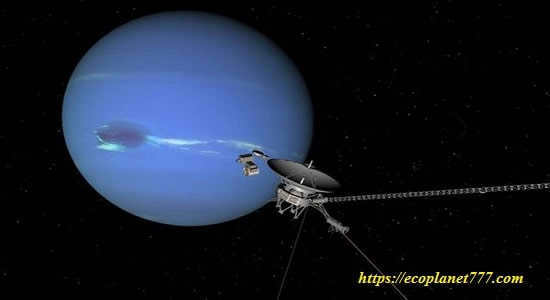
Uranus is the third largest planet in the solar system and it has the coldest atmosphere. The majority of its interior is composed of ice and rock, and it is home to twenty-seven known natural satellites. Unlike Saturn, Uranus is located twice as far away. In the past, astronomers were unable to detect Uranus and it was the first planet to be discovered through a telescope. Although it is possible to see Uranus with the naked eye, a large telescope is required to see its disk. In 1997, when Uranus passed in front of a distant star, it was observed that the planet also has rings. Voyager 2 later confirmed this, revealing that Uranus has 11 concentric rings that are much fainter than Saturn’s rings.
One of the most notable features of Uranus is its unique axis of rotation, which is aligned with its orbit around the Sun. As a result, the poles of Uranus align with the Sun every six months. In contrast, the axes of other planets are generally perpendicular to the elliptical plane.
Initially, it was believed that Uranus had five prominent moons. However, upon closer observation by a probe, an additional 10 moons were discovered. The five largest moons have a diameter of approximately 1,000 kilometers each and bear a resemblance to Jupiter’s Galanos moons. These moons are composed primarily of ice and rocks. They have been named Ariel, Umbriel, Titania, Oberon, and Miranda. Miranda, in particular, has a surface characterized by mountains and deep depressions. In Figure 11, there is an artist’s depiction of what Uranus would look like when viewed from Miranda, which is situated in the foreground.
Neptune
Reword the text to make it unique using the English language, while preserving the HTML markup:
The planet Neptune
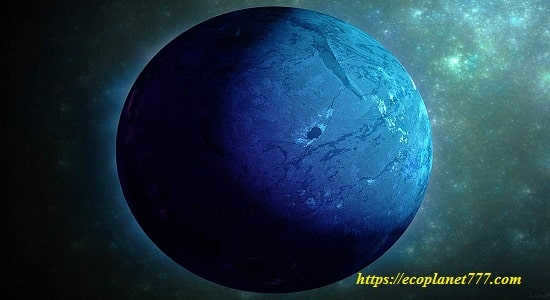
Did you know these fascinating details about the planets? The inner layers of Neptune and Uranus consist primarily of frozen substances.
This incredible celestial body is ranked as the fourth largest planet and bears a striking resemblance to Uranus in terms of its composition, housing a significant amount of ice and rock within. Its mesmerizing blue hue is a result of the abundance of methane gas on its surface. Additionally, scientists have identified a total of fourteen satellites orbiting around Neptune.
Astronomical Body That Orbits Another Celestial Object
A natural satellite is an astronomical body that orbits another star or planet and moves with it in an orbit around the star. It is characterized by being solid, smaller in size compared to the star it orbits, and can either be bright or opaque. Some planets may have multiple natural satellites that are held together by the mutual gravitational forces between them.
The Moon, which is approximately one-quarter the size of Earth’s diameter, serves as the natural satellite of our planet. It is the fifth largest satellite in the entire solar system. The Moon is situated at a distance from Earth that is thirty times the diameter of our planet. It takes twenty-seven days for the Moon to complete one revolution around Earth and its own axis, resulting in the same side of the Moon always being visible from Earth’s surface.
An artificial satellite differs from a natural satellite in that it is created by humans. Additionally, it remains in orbit around celestial bodies in space and, upon reaching the end of its lifespan, can either remain as space debris or disintegrate upon reentry into the Earth’s atmosphere.
To learn more about space debris, click here.
There are several methods to differentiate stars from planets using the unassisted eye. With these straightforward suggestions, you will never mistake stars for planets.
- Planets are moving celestial bodies without a specific direction.
- A star can either be in motion or stationary.
- A star generates its own light while remaining in place.
- A planet in constant motion is only illuminated when it comes close to a stationary star. For example, the Earth is illuminated by the sun.
- A star is formed before a planet, as it is the outcome of the creation of a mature star.
- Planets have their own motion, while stars do not. As we know, planets orbit their own path and revolve around the sun, causing their position in the night sky to change each night.
- Stars twinkle, while planets remain steady. The layers of our atmosphere distort starlight, causing it to appear to flicker or twinkle to the naked eye. A similar phenomenon occurs on hot summer days when we observe the asphalt from a distance and it appears to shake due to the rising hot air. This is essentially the same effect that causes stars to twinkle. However, it’s important to note that not all stars twinkle all the time. The visibility of twinkling depends on atmospheric disturbances, which are more noticeable during periods of instability, such as after a thunderstorm or on a hot summer day. On the other hand, planets do not twinkle. They are much closer to Earth and their light appears as a steady disk of light. The intensity of the light from planets and their larger size protect them from being as affected by atmospheric changes. However, in extreme atmospheric conditions, there may be a slight flicker in the light of planets.
- The planets are situated within the ecliptic, which is a representation of the solar system on a plane. To distinguish between stars and planets, we can observe their flickering. However, if we come across a steady light in the sky that does not flicker, how can we determine if it is a planet or a star? The key is to understand that planets orbit the Sun and are generally “aligned” or located in the same plane. Therefore, if we witness them forming a straight line in the sky, we can be confident that it is a planet. This line is known as the ecliptic, which depicts the solar system on a plane. The ecliptic represents the path that the sun follows throughout the day, moving from east to west. Consequently, all the planets (including the moon) must reside within this band. Any fixed point of light outside of the ecliptic cannot be a planet.
- When observing a planet from Earth, it is important to verify that it does not flicker. It is crucial to remember that planets are seen by the light of the sun and do not emit their own light. Additionally, planets may change their position in the sky throughout the night.
- In contrast, stars are stationary in the sky and emit their own light. However, when looking at stars through the various layers of the atmosphere, they appear to twinkle.
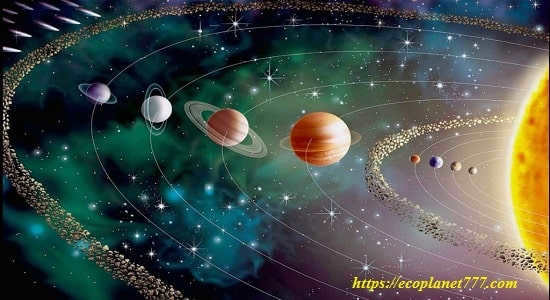
Stars, like the Sun, emit their own light, which is why they are so luminous at night. In contrast, planets in any galaxy rely on a star’s illumination to receive light.
What sets the Sun apart from other celestial bodies? The Sun is unique in that it emits its own light by burning hydrogen and converting it into helium through nuclear fusion.
Stars are the radiant objects visible in the night sky. Planets, satellites, and comets are non-luminous celestial bodies that also appear bright in the sky because they reflect the light of a star. This is why the Moon, a satellite, shines by reflecting the light of the Sun.
The Sun stands out from other stars due to its proximity to us. Sunspots are observable on the Sun’s surface. A star, on the other hand, is an intensely hot sphere that emits light and heat as a result of its internal luminosity.
P.S.
If you enjoyed and found this information helpful, please share it on social media with your friends and acquaintances. By doing so, you will be supporting our project, “Ecology of Life,” and making a contribution to environmental preservation!
The “Ecology of Life” project is designed for those who value and wish to safeguard their health and the planet we call home! We have a deep affection for nature and living an eco-friendly lifestyle!
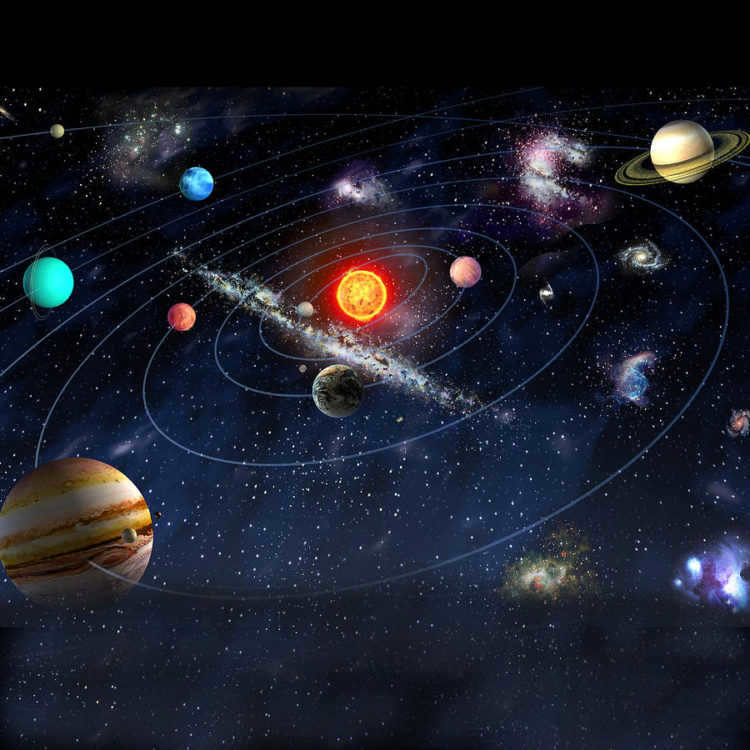
- Planets
The solar system consists of a collection of celestial bodies revolving around a radiant star, known as the Sun. This celestial body serves as the primary source of both heat and light within the solar system.
It is widely accepted that our planetary system originated from the cataclysmic explosion of one or more stars, occurring approximately 4.5 billion years ago. Initially, the solar system existed as a conglomeration of gas and dust particles, which gradually coalesced due to gravitational forces, resulting in the formation of the Sun and the subsequent emergence of other planets.
The celestial bodies in the solar system
Positioned at the heart of the solar system stands the Sun, encircled by a cohort of eight celestial bodies that include Mercury, Venus, Earth, Mars, Jupiter, Saturn, Uranus, and Neptune.
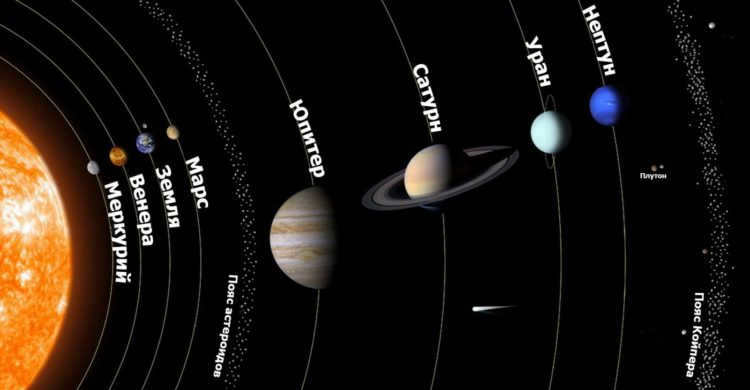
Up until 2006, Pluto was considered the 9th planet from the Sun and belonged to this group of planets. However, due to its small size and significant distance from the Sun, it was excluded from the list of planets and reclassified as a dwarf planet. Specifically, it is one of the several dwarf planets located in the Kuiper belt.
Typically, the planets mentioned above are divided into two main groups: the terrestrial group and the gas giants.
The terrestrial group consists of planets like Mercury, Venus, Earth, and Mars. These planets are known for their small size, rocky surfaces, and their proximity to the Sun.
Mercury
Mercury is the closest planet to the Sun in our solar system. It is named after the Roman god Mercury, known for his speed and agility. With a diameter of only 4,879 kilometers, Mercury is the smallest planet in our solar system. It is also one of the hottest, with temperatures reaching up to 800 degrees Fahrenheit (430 degrees Celsius) during the day. Despite its small size and extreme temperatures, Mercury has a surprisingly dense atmosphere. It is composed mainly of oxygen, sodium, hydrogen, helium, and potassium. Mercury’s surface is covered in craters, cliffs, and plains. It has no moons or rings. The planet is often visible from Earth, especially during certain times of the year. Scientists have been studying Mercury for centuries and continue to learn more about its unique characteristics and place in our solar system.
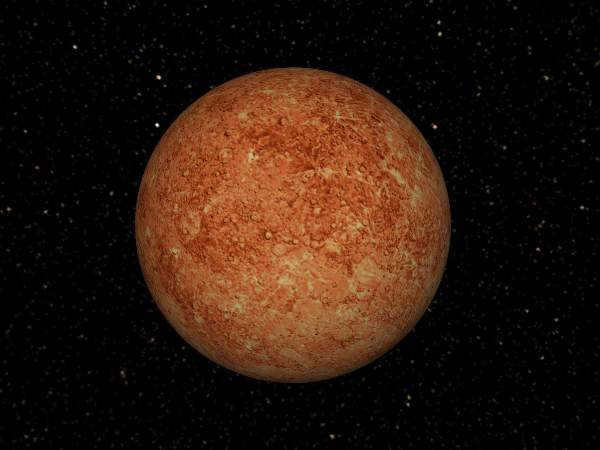
Mercury is one of the smallest planets in our solar system, with a diameter of 4,879 km. It is also the closest planet to the Sun, which results in a significant temperature difference. During the day, the average temperature on Mercury reaches +350 degrees Celsius, while at night it drops to -170 degrees Celsius.
- Mercury is positioned as the first planet in our solar system, being closest to the Sun.
- One interesting fact about Mercury is that it doesn’t experience any seasons. This is due to the planet’s axis being almost perpendicular to its orbit around the Sun.
- Despite being the closest planet to the Sun, Mercury does not have the highest surface temperature. That distinction goes to Venus.
- Mariner 10 was the initial spacecraft to explore Mercury, conducting a series of demonstration flybys in 1974.
- A single day on Mercury lasts for 59 Earth days, while a year is completed in just 88 days.
- Mercury experiences the most extreme temperature fluctuations, with highs reaching 610 °C. During the day, temperatures can soar to 430 °C, while dropping to -180 °C at night.
- The gravitational force on Mercury’s surface is only 38% of Earth’s, allowing for three times higher jumps and easier lifting of heavy objects.
- Galileo Galilei made the first recorded observations of Mercury through a telescope during the early 17th century.
- Mercury lacks any natural satellites.
- It was not until 2009 that the first official map of Mercury’s surface was released, made possible by the data gathered by the Mariner 10 and Messenger spacecraft.
Venus
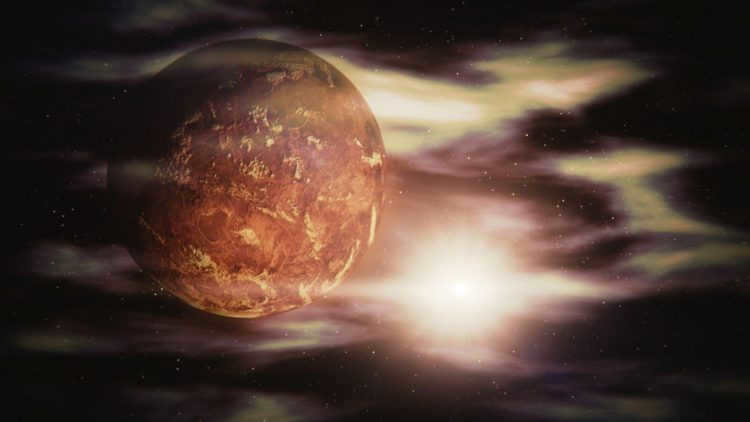
This celestial body is positioned as the second planet in the solar system, right after the Sun. It has a similar size to Earth with a diameter of 12,104 km. However, Venus exhibits notable differences from our home planet in various aspects. For instance, a single day on Venus lasts 243 Earth days, while a complete orbit around the Sun takes 255 days. The atmosphere surrounding Venus consists primarily of carbon dioxide, making up about 95% of its composition. This abundance of carbon dioxide induces a greenhouse effect, resulting in an average surface temperature of a scorching 475 degrees Celsius. In addition to carbon dioxide, the atmosphere also contains approximately 5% nitrogen and 0.1% oxygen.
- Venus occupies the second position among the planets in our solar system, following the Sun.
- Despite being the second planet from the Sun, Venus holds the title for the hottest planet in the solar system. Its surface temperature can soar up to 475 °C.
- Venus 1, launched from Earth on February 12, 1961, became the pioneering spacecraft sent to explore the wonders of Venus.
- Venus is one of the few planets in the solar system that rotates in a different direction from most planets.
- The planet’s orbit around the Sun is nearly circular.
- The temperature on Venus remains relatively constant throughout the day and night due to the atmosphere’s high thermal inertia.
- Venus takes 225 Earth days to orbit the Sun and 243 Earth days to complete one rotation on its axis, making a day on Venus longer than a year.
- Galileo Galilei was the first to observe Venus through a telescope in the early 17th century.
- Venus does not have any natural satellites.
- After the Sun and the Moon, Venus is the third brightest object in the sky.
Planet Earth
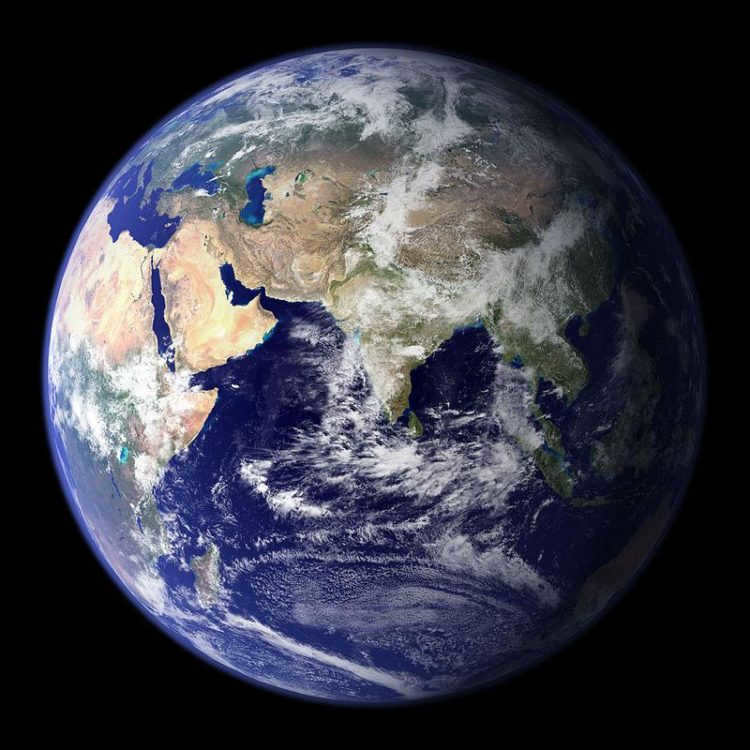
The Earth is situated 150 million kilometers away from the Sun, allowing for the creation of a temperature suitable for the presence of liquid water on its surface, and thus enabling the development of life.
Approximately 70% of the Earth’s surface is covered by water, making it the only planet in the solar system with such a significant amount of liquid. It is believed that thousands of years ago, vapor in the atmosphere generated the necessary temperature for liquid water to form on the Earth’s surface, and solar radiation played a crucial role in photosynthesis and the emergence of life on the planet.
- Earth is the third planet in the solar system, located at a distance from the Sun.
- The Earth has one natural satellite, the Moon, which orbits around it.
- Earth possesses the highest density among all the planets in our solar system;
- The rotation rate of Earth is gradually decelerating;
- The average distance between Earth and the Sun is 1 astronomical unit (a commonly used unit of measurement in astronomy), which is approximately equal to 150 million kilometers;
- Earth is equipped with a magnetic field of sufficient strength to shield living organisms on its surface from potentially harmful solar radiation;
- The first man-made satellite to orbit Earth, known as PS-1 (Simplest Satellite – 1), was launched from Baikonur Cosmodrome using a Sputnik booster on October 4, 1957;
- Earth boasts the largest number of spacecraft currently orbiting around it compared to any other planet;
- Earth stands as the largest planet within the Earth-group in our solar system;
Red Planet
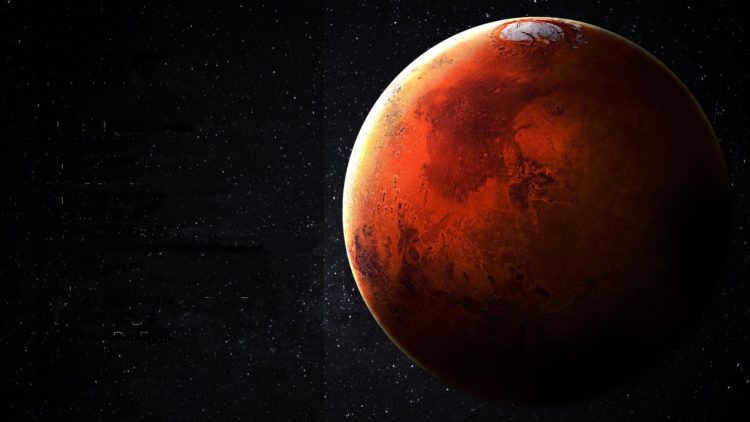
Mars is the fourth planet from the Sun and is located 1.5 times farther away from the Sun compared to Earth. It has a smaller diameter of 6,779 kilometers. The planet experiences a wide range of temperatures, from -155 degrees Celsius to +20 degrees Celsius at the equator. Mars has a weaker magnetic field and a rarefied atmosphere, which allows solar radiation to reach the surface unhindered. This means that if there is any life on Mars, it is unlikely to be found on the surface.
Exploration by Mars rovers has revealed the presence of mountains, dried up riverbeds, and glaciers on the planet. The surface of Mars is covered with red-colored sand, which is caused by iron oxide.
- Mars is situated on the fourth orbit from the Sun;
- The Red Planet boasts the highest volcano in the entire solar system;
- Out of the 40 exploratory missions dispatched to Mars, only 18 have achieved success;
- Mars experiences the most massive dust storms in the entire solar system;
- In the next 30-50 million years, Mars will acquire a ring system similar to that of Saturn;
- Fragments from Mars have been discovered on Earth;
- The Sun appears half the size on the surface of Mars compared to its appearance on the surface of Earth;
- Mars is the sole planet in the solar system that possesses polar ice;
- Mars is orbited by two natural satellites, Deimos and Phobos;
- Mars lacks a magnetic field;
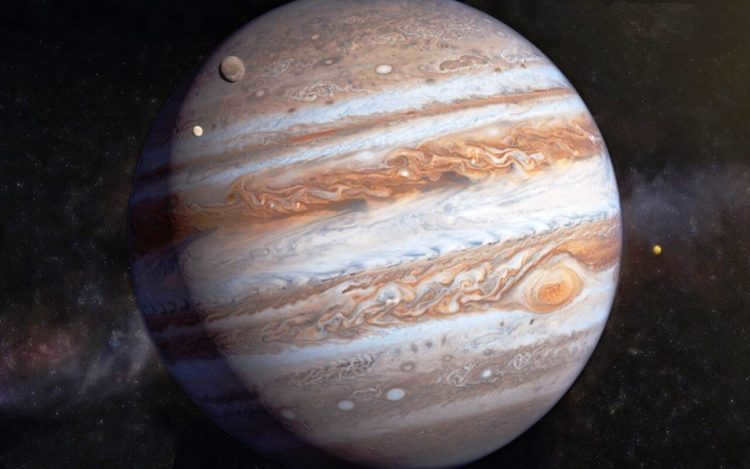
This celestial body is the largest in our solar system and boasts a diameter of 139,822 km, which is a whopping 19 times bigger than the diameter of Earth. A single rotation on Jupiter takes 10 hours, while a full orbit around the Sun lasts approximately 12 Earth years. Jupiter’s composition is primarily made up of xenon, argon, and krypton. If it were 60 times larger, it could potentially ignite and become a star through a spontaneous thermonuclear reaction.
With an average temperature of -150 degrees Celsius, Jupiter is an extremely cold planet. Its atmosphere is predominantly composed of hydrogen and helium, with no traces of oxygen or water on its surface. Some theories suggest that there may be ice present within Jupiter’s atmosphere.
- Jupiter is situated in the fifth orbit from the Sun.
- In Earth’s sky, Jupiter is the fourth brightest object, following the Sun, Moon, and Venus.
- Jupiter holds the record for having the shortest day among all the planets in our solar system.
- The Great Red Spot, one of the most powerful and longest storms in the solar system, is currently raging in Jupiter’s atmosphere;
- Ganymede, one of Jupiter’s moons, holds the title for being the largest moon in the entire solar system;
- Jupiter is surrounded by a thin ring system;
- Over the years, Jupiter has been visited by a total of 8 scientific research vehicles;
- Jupiter possesses a strong magnetic field;
- If Jupiter were 80 times more massive, it would have the potential to become a star;
- With a total of 67 natural satellites orbiting around it, Jupiter claims the record for having the highest number of moons in the entire solar system;
Saturn
Saturn is the sixth planet from the sun and the second-largest in the solar system, after Jupiter. It is a gas giant with an average radius about nine times that of Earth. Saturn is named after the Roman god of agriculture and wealth. It is known for its beautiful ring system, which is made up of ice particles and rocky debris. The rings are believed to be remnants of a moon that was shattered by the planet’s gravity. Saturn has a complex weather system, with powerful storms and a distinctive hexagonal jet stream at its north pole. The planet has over 80 moons, the largest of which is Titan. Saturn is a popular subject of study for astronomers and has been visited by several spacecraft, including the Cassini-Huygens mission.
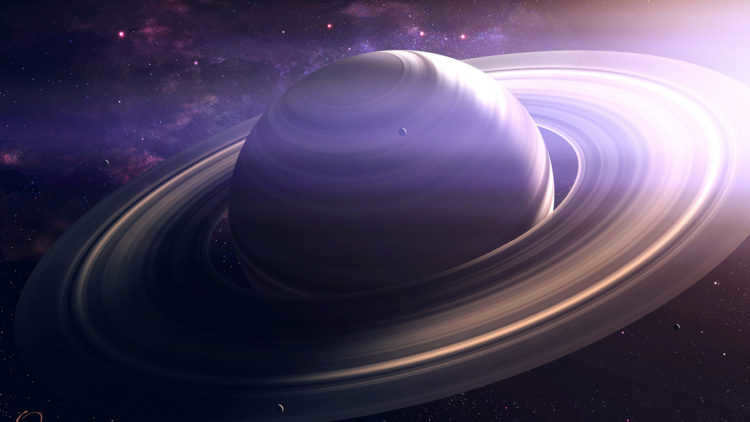
This celestial body is the second largest within our solar system. With a diameter of 116,464 kilometers, it is only surpassed in size by one other planet. In terms of composition, it bears a striking resemblance to the Sun. The duration of a year on this planet is significantly longer than on Earth, lasting nearly 30 Earth years, while a single day is a mere 10.5 hours. The average temperature on its surface is an astonishingly frigid -180 degrees Celsius.
Comprised mostly of hydrogen with a small amount of helium, its atmosphere is a volatile mix. Thunderstorms and auroras are common occurrences within its upper layers.
- Saturn, the sixth planet from the Sun;
- Home to the solar system’s most powerful winds, Saturn’s atmosphere;
- Among the least dense planets in our solar system;
- Surrounded by the largest ring system within our solar system;
- The duration of one day on Saturn is almost equivalent to one Earth year, which lasts for 378 Earth days;
- Four research spacecrafts have been sent to explore Saturn;
- Saturn, together with Jupiter, accounts for approximately 92% of the total planetary mass in the solar system;
- A single year on Saturn is equivalent to 29.5 Earth years;
- Saturn has a total of 62 known natural satellites orbiting around it;
- The Cassini Automated Interplanetary Station is currently conducting studies on Saturn and its rings;
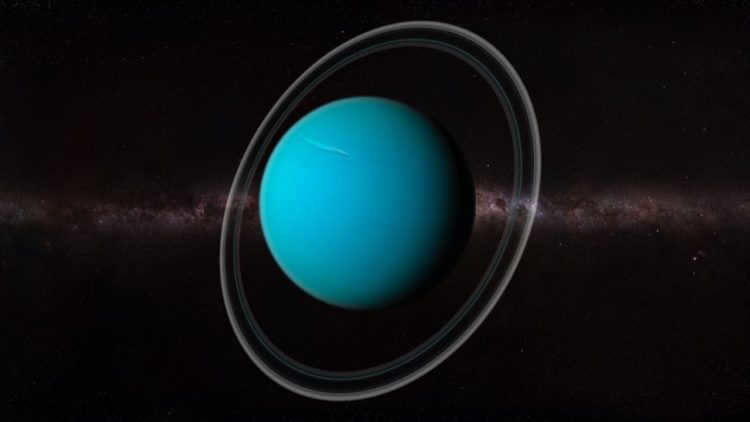
Uranus is the seventh planet from the Sun and the third largest in the solar system, with a diameter of 50,724 kilometers. It is often referred to as the “ice planet” due to its surface temperature of -224 degrees Celsius. A day on Uranus lasts for 17 hours, while a year takes 84 Earth years to complete. Interestingly, summer and winter on Uranus last for 42 years each. This unique phenomenon is a result of the planet’s axis being tilted at a 90-degree angle to its orbit, causing Uranus to appear as if it is “lying on its side”.
- Uranus is situated on the seventh orbit from the Sun.
- The discovery of Uranus was first made by William Herschel in 1781.
- Uranus has only been explored by one spacecraft, Voyager 2, in 1982.
- Uranus holds the title for being the coldest planet in the solar system.
- The equatorial plane of Uranus is inclined at an almost right angle to the plane of its orbit – in other words, the planet rotates in a retrograde motion, “tilted slightly upside down”;
- The moons of Uranus are named after the works of William Shakespeare and Alexander Pope, rather than Greek or Roman mythology;
- A day on Uranus lasts approximately 17 Earth hours;
- There are 13 known rings encircling Uranus;
- One year on Uranus is equivalent to 84 Earth years;
- Uranus is orbited by 27 known natural satellites;
The planet Neptune
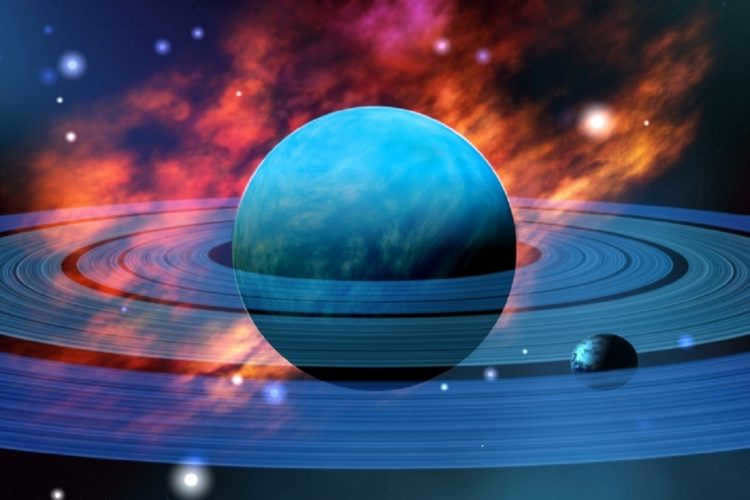
Neptune, the eighth planet from the Sun, shares similarities in composition and size with its neighboring planet Uranus. With a diameter of 49,244 kilometers, Neptune has a day that lasts 16 hours and a year that is equivalent to 164 Earth years. Classified as an ice giant, it was previously believed that Neptune’s icy surface did not experience any weather phenomena. However, recent discoveries have revealed that Neptune possesses the highest wind speed of any planet within the solar system, reaching up to 700 kilometers per hour.
In addition to its unique characteristics, Neptune is home to 14 satellites, the most notable being Triton, which is known to have its own atmosphere.
Unlike other planets, Neptune also boasts the presence of six rings.
- Neptune, the most distant planet in the solar system, resides in the eighth orbit from the Sun;
- Neptune is orbited by a total of 14 satellites;
- The average distance between Neptune and the Sun is 30 astronomical units;
- The duration of a day on Neptune is equivalent to 16 Earth hours;
- Neptune has only been explored by Voyager 2, making it the sole spacecraft to visit the planet;
- Neptune possesses a ring system encircling its atmosphere;
- Neptune’s gravity is the second strongest among all planets, surpassed only by Jupiter;
- A single year on Neptune spans a period of 164 Earth years;
- The atmosphere of Neptune is highly dynamic and characterized by intense activity;
50 fascinating facts about our solar system
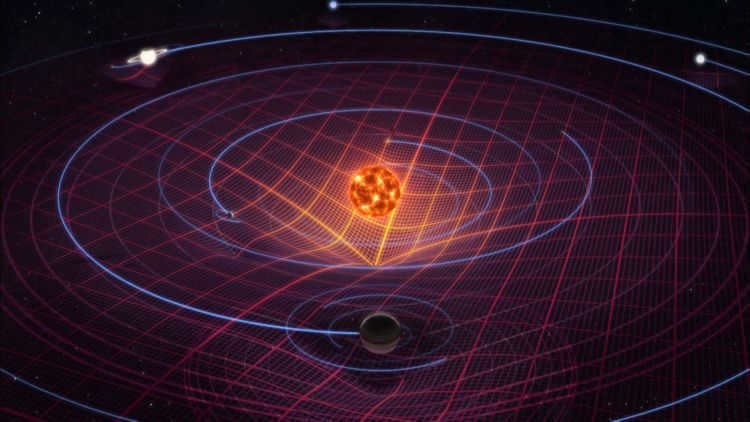
- Jupiter is known as the largest celestial body in the entire solar system.
- Within our solar system, there are a total of 5 dwarf planets, with one of them being reclassified as Pluto.
- There is a scarcity of asteroids present within the solar system.
- Venus holds the title for being the most scorching planet within our solar system.
- The Sun dominates approximately 99% of the total volume within the solar system.
- One of the most mesmerizing and unique destinations within the solar system is the moon of Saturn. It boasts vast quantities of ethane and liquid methane.
- Our solar system possesses a distinctive tail that bears a resemblance to a four-leaf clover.
- The Sun follows a consistent 11-year cycle of activity.
- The solar system consists of a total of 8 planets.
- The formation of the solar system is attributed to a massive cloud of gas and dust.
- All spacecraft have successfully reached every planet in the solar system.
- Out of all the planets in the solar system, Venus stands out as the only one that rotates counterclockwise on its axis.
- Uranus boasts a total of 27 satellites.
- Mars is home to the largest mountain in the solar system.
- A vast number of objects within the solar system originated from the Sun.
- The solar system is a constituent part of the Milky Way galaxy.
- The central object in the solar system is none other than the Sun itself.
- For the purpose of categorization, the solar system is often divided into various regions.
- The Sun plays a pivotal role as a key component of the solar system.
- The formation of the solar system took approximately 4.5 billion years to complete.
- Pluto, the most distant planet in the solar system, lies at the outermost reaches.
- Two distinct regions within the solar system are inhabited by numerous small celestial bodies.
- If you compare space and the solar system, it becomes evident that the solar system is just a tiny speck within it.
- In the course of the last few centuries, the solar system has actually lost two planets: Vulcan and Pluto.
- Scientists are confident that the solar system was artificially created.
- Titan, the only moon in the solar system with a dense atmosphere, remains hidden beneath a shroud of clouds.
- The region of the solar system that extends beyond Neptune’s orbit is referred to as the Kuiper belt.
- Comets with long orbital periods originate from the Oort cloud, a region in the solar system.
- Every celestial object within the solar system is gravitationally bound to it.
- The prevailing theory regarding the formation of planets and moons within the solar system involves their emergence from a colossal cloud.
- The universe has many secrets, but one of the most mysterious parts is the solar system.
- Within the solar system, there is a vast asteroid belt that holds many secrets.
- Mars is home to Olympus, the largest volcano in the entire solar system, and its eruptions are a sight to behold.
- As we venture to the outskirts of the solar system, we find Pluto, a dwarf planet with its own unique mysteries.
- Jupiter, the largest planet in the solar system, hides a massive ocean of liquid water beneath its clouds.
- Among the numerous satellites in the solar system, the moon stands out as the largest and most captivating.
- Pallada, the largest asteroid in the solar system, holds its own secrets and intrigues scientists.
- When it comes to brightness, Venus takes the crown as the most radiant planet in the solar system.
- Hydrogen dominates the composition of the solar system, making up the majority of its substance.
- Earth, our home planet, is an equal and essential member of the solar system.
- While the sun may seem unchanging, it slowly heats up as it continues to burn.
- Surprisingly, the sun contains the largest supply of water in the entire solar system, a curious fact indeed.
- The orbital plane of each planet in the solar system deviates from the equatorial plane.
- Phobos, a moon of Mars, is an anomaly within our solar system.
- The solar system is remarkable for its vast array of celestial bodies and its immense scale.
- The Sun exerts a significant influence on the planets within the solar system.
- The outer region of the solar system is home to gas giants and a multitude of satellites.
- A considerable number of planetary satellites within the solar system are no longer operational.
- Ceres, the largest asteroid measuring 950 kilometers in diameter, holds that title within our solar system.
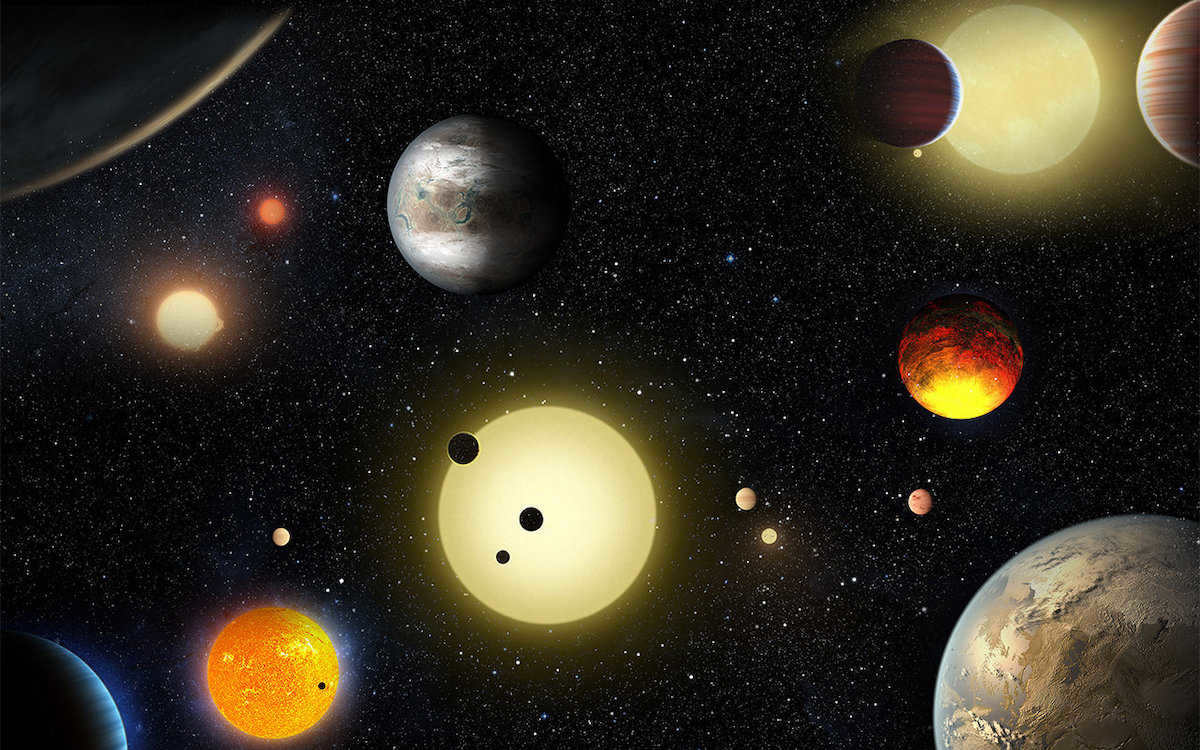

The term “exoplanet” refers to planets that exist beyond our solar system. In other words, they are located outside of our familiar planetary system. Similar to Earth, many exoplanets orbit around stars, while others are not bound to a specific star’s orbit.
The majority of the exoplanets that have been found are situated within the confines of the Milky Way, which is the same region of our Galaxy that we occupy. With the aid of advanced telescopes, scientists are able to accurately determine the dimensions, composition, and surface characteristics of these distant planets. Interestingly, the elements that make up these exoplanets are very similar to those found in our own solar system. However, there are variations in the combinations and proportions of these elements. Some exoplanets contain more water and ice, while others have a greater abundance of iron and carbon. It is worth noting, though, that no exoplanet has been discovered that is an exact replica of Earth or any other celestial body within our solar system.
Types of exoplanets
There are various types of exoplanets in our Galaxy, which consists of a vast number of stars, including the Sun. With at least 100 billion stars in the Milky Way, the number of undiscovered exoplanets seems almost infinite. Scientists believe that each star has its own planetary system, potentially hosting multiple planets. Therefore, the total number of exoplanets within our galaxy could easily reach the trillions.
For countless generations before ours, there has been speculation about the potential presence of planets outside our solar system. Today, we have definitive proof that exoplanets do exist and that there are numerous ones out there. However, despite our advancements, we are still unable to reach any of them. The nearest star to Earth, Proxima Centauri, is known to have at least one planet. This planet is believed to be similar to Earth and may even have water. However, in order to reach it, we would have to travel over four light years, and scientists have yet to fully understand its properties and determine if it is habitable. As for other exoplanets, they are located hundreds or even thousands of light years away from us, making it currently impossible to visit them.
It has been nearly 30 years since the discovery of the first exoplanet, and yet we still have much to learn about the diverse range of planets that exist. As a result, our categorization of exoplanets remains somewhat arbitrary.
Gas giants
Gas giants such as Jupiter and Saturn exist in the vastness of space. Currently, there are 1,367 known exoplanets of this category. Among the most renowned examples are:
51 Pegasi b – a gas giant with an atmospheric temperature exceeding 1000 °C. It holds the distinction of being the first planet discovered among those orbiting stars similar to our sun.
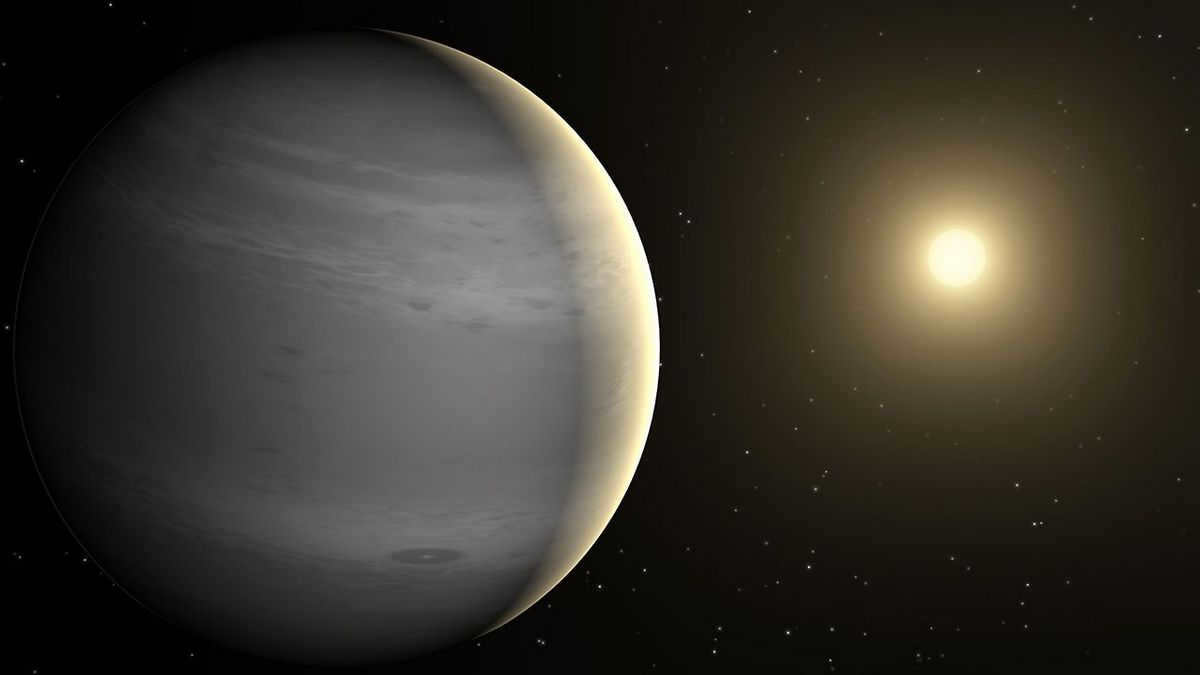
KELT-9 b is currently recognized as the most scorching exoplanet in existence. The temperatures on its illuminated side can reach an astonishing 4,600 °C. Situated roughly 667 light-years away from our home planet, it stands as an impressive celestial object.
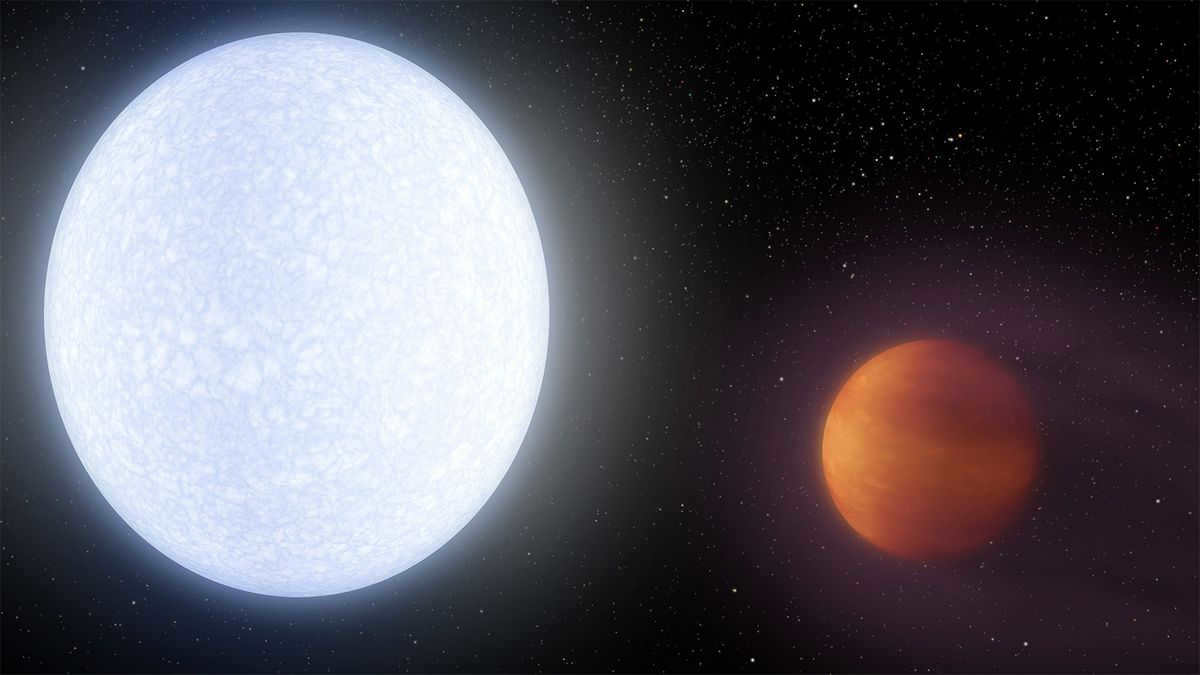
Exoplanets similar to Neptune
These are small planets with atmospheres primarily composed of hydrogen and helium. A total of 1,484 exoplanets have been identified, with the most well-known being:
Kepler-1655 b – An exoplanet similar to Neptune. It completes one orbit around its star (equivalent to one year on Kepler) in just 11.9 days. This exoplanet was first discovered in 2018.
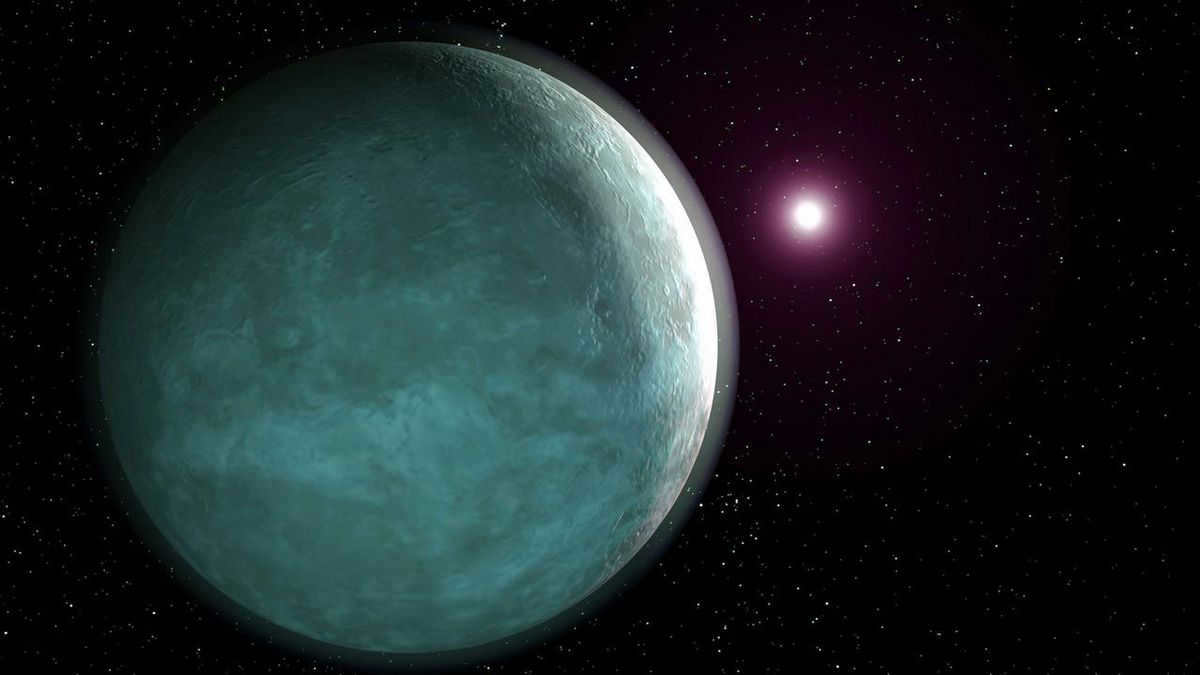
GJ 436 b is an exoplanet located in relatively close proximity to Earth. It would require a 32-year journey to reach this celestial body.
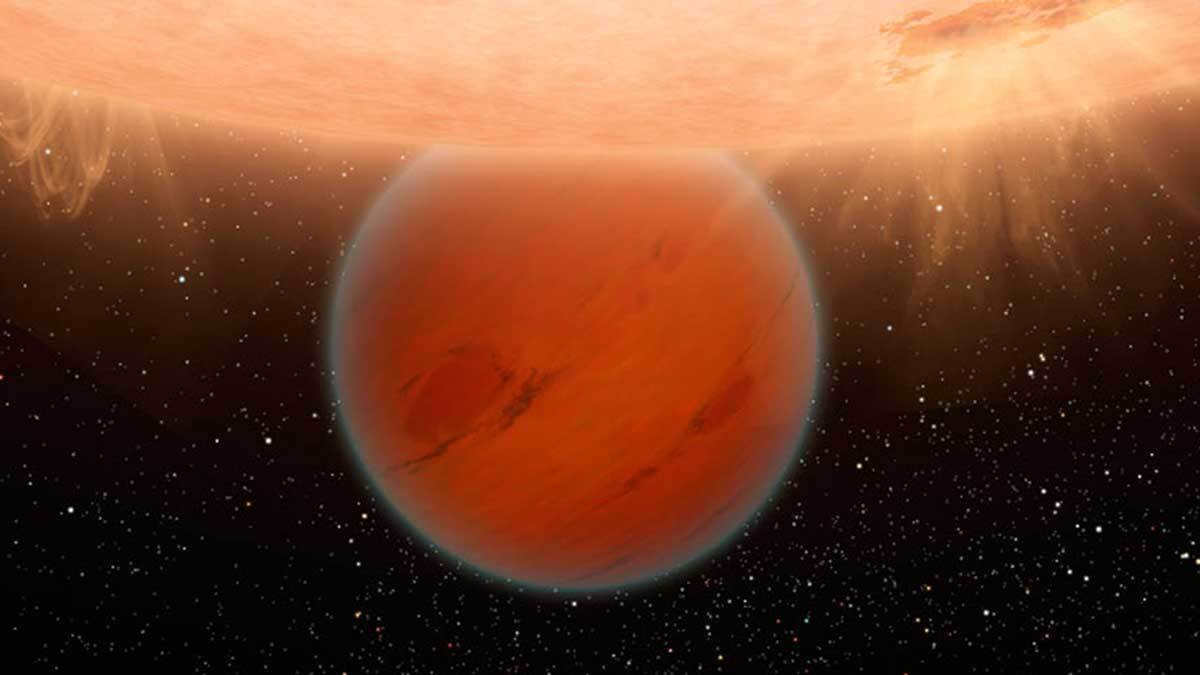
Super-Earths
Exoplanets composed of gas, rock, and various combinations thereof that are larger than Earth by several times. A total of 1,346 planets have been discovered, with the most well-known ones being:
Barnard’s Star b – the second closest exoplanet to Earth, which is a six-year journey away. This planet was detected in 2018 and is 3.2 times the size of our own planet. The star around which the exoplanet orbits only provides it with 2% of the energy that Earth receives from the Sun.
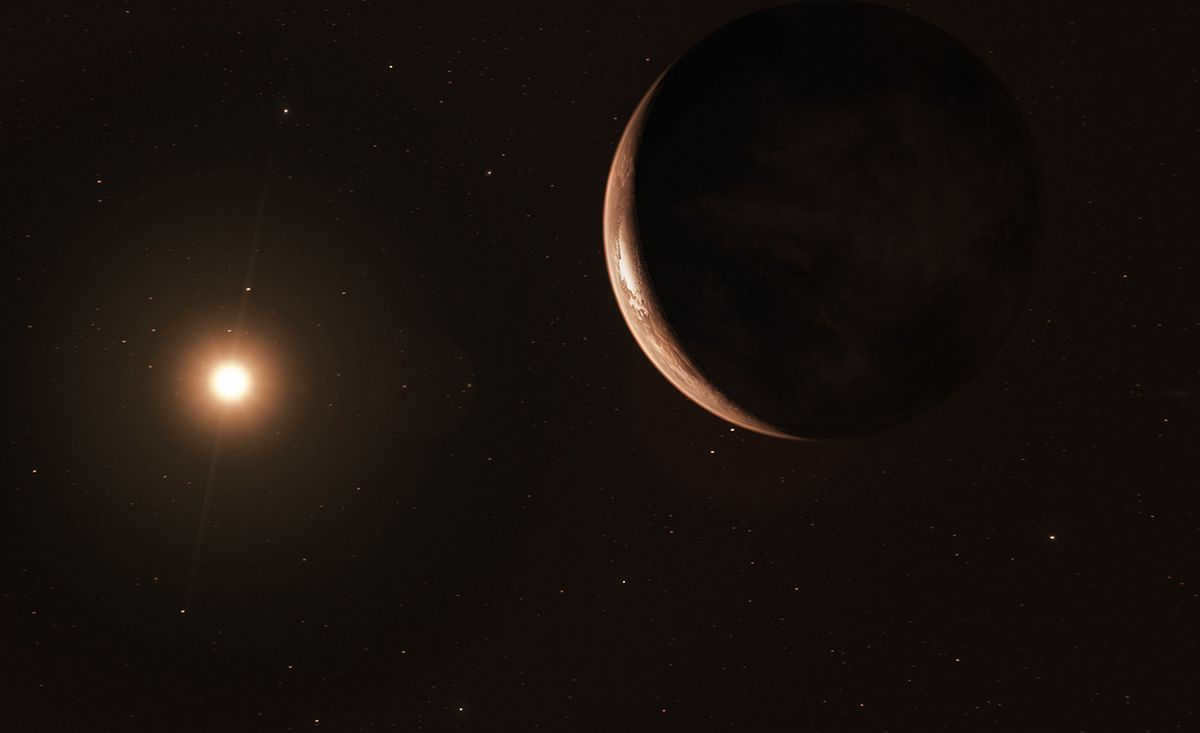
GJ 15 A b is a super-Earth exoplanet located 11 light-years away from Earth and orbiting a red dwarf star. This exoplanet is particularly unique because it has its own planetary system, making it the closest super-Earth to Earth with such a system.
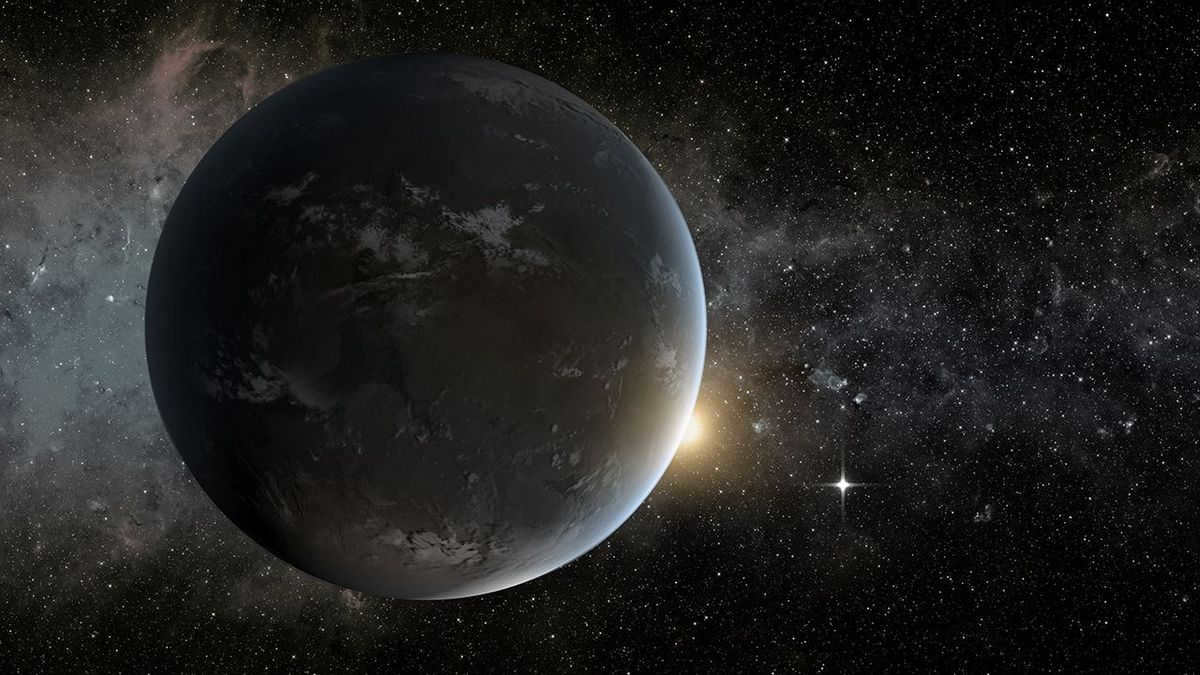
Planets similar to Earth
Planetary bodies with rocky compositions, resembling Earth, Mars, or Venus. A total of 164 planets have been identified, with some of the most well-known being:
TRAPPIST-1 e – This planet has a mass 60% that of Earth and completes one orbit around its star in just 6.1 days. It was first discovered in 2017.
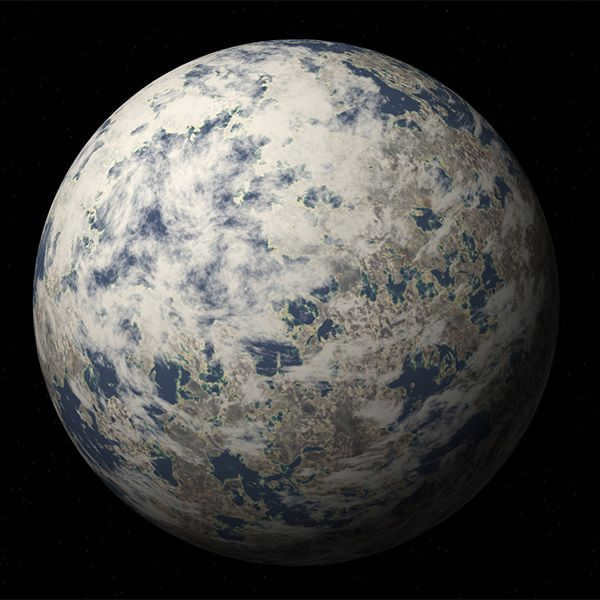
TRAPPIST-1 d – similar to our planet, is positioned as the third planet from its star. It is composed of rock and has an average surface temperature of approximately 2290 degrees Celsius.
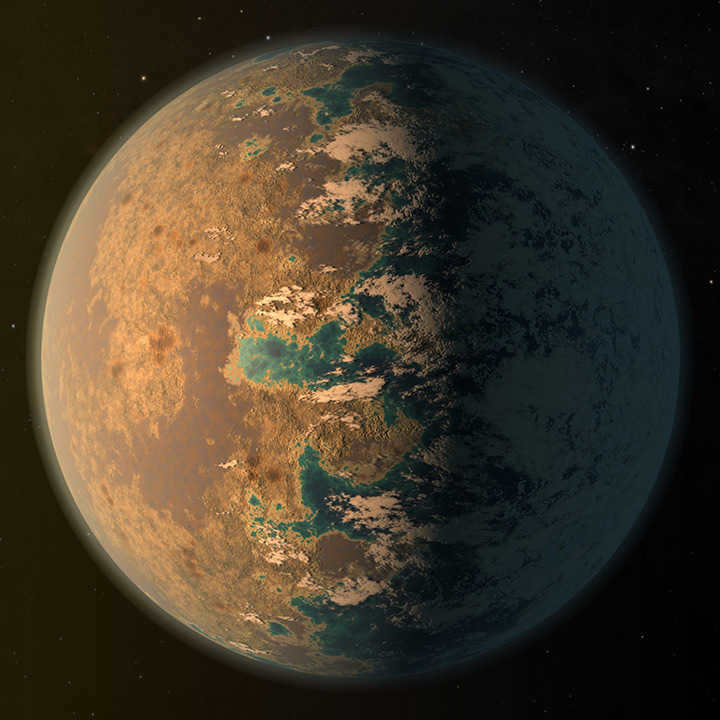
How exoplanets are detected
Exoplanets are discovered using advanced telescopes that are positioned either on Earth or in space. A study conducted with NASA’s Kepler Observatory Space Telescope revealed that there are more planets than stars in our Milky Way galaxy. This groundbreaking data was obtained through statistical analysis. Scientists now have the understanding that small planets are incredibly common throughout the galaxy. However, their detection poses significant challenges, as their size can make them invisible to telescopes and they do not emit light like stars do. Additionally, the bright light emitted by a star can overshadow the presence of a planet, making it akin to trying to spot a speck of dust within a lit bulb.
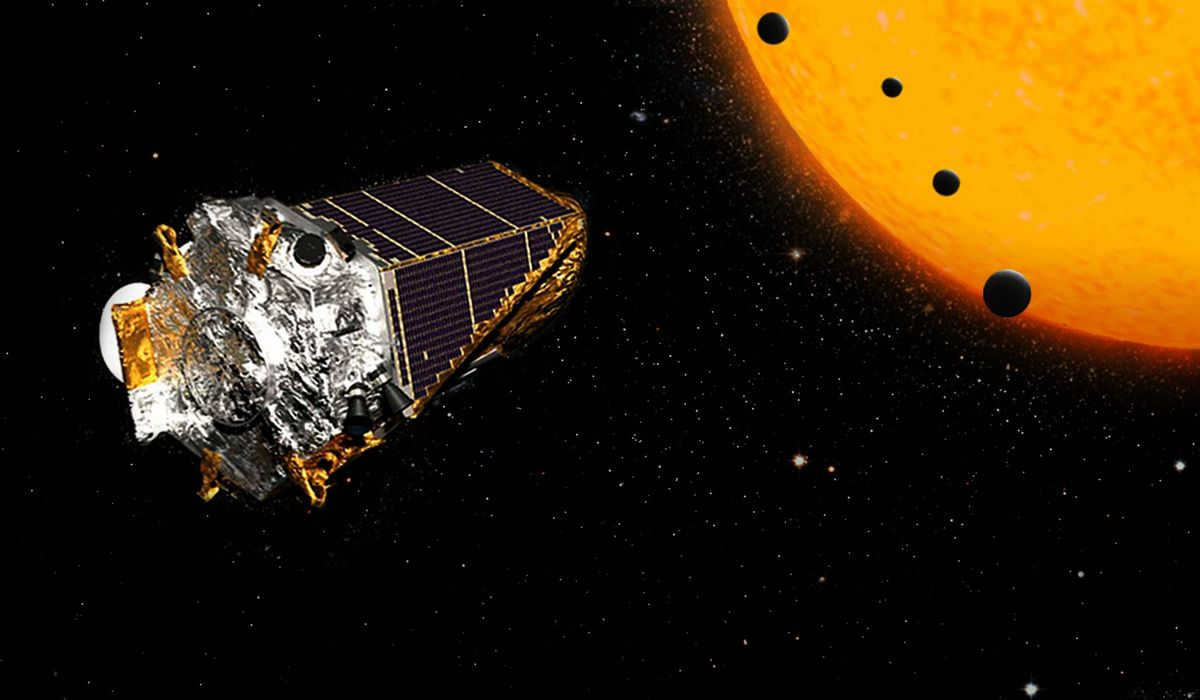
To locate an exoplanet, astronomers engage in the pursuit of identifying indications of a celestial body revolving around its parent star. The characteristics of a star have the potential to be altered when there is a planetary orbit in place. Initially, the planet’s presence influences the star’s rotation, causing a slight wobble which can be detected with specialized equipment. This alteration can solely be attributed to the planet’s gravitational pull. Additionally, a high-powered telescope has the capability to capture the diminutive shadow cast by the planet onto the star. While there exist alternative methodologies for exoplanet detection, these two approaches are deemed primary and are predominantly utilized.
Despite the presence of such techniques, scientists still lack the capacity to uncover all planets. As of now, no system resembling the solar system has been detected. This may suggest that contemporary telescopes are incapable of detecting small planets. Furthermore, numerous planets revolve at great distances from their respective stars, receiving minimal illumination, rendering them nearly undetectable from afar.
Latest forecasts for exoplanetary investigation
Advanced observatories and cutting-edge technology will facilitate the discovery of an increasing number of exoplanets. These advancements will bring us closer to locating exoplanets that resemble Earth: ones that have relatively distant orbits from their host stars and are compact in size.
The James Webb Space Telescope.
An immense telescope, comparable in size to a tennis court, is scheduled to be launched into space from French Guiana in 2021. This telescope will scrutinize the cosmos using infrared light, investigate the genesis of planetary systems, and examine the composition of exoplanetary atmospheres. It is anticipated to become the foremost space instrument in the present decade.
